- Game-Maps.com
- DAI Maps & Guide
- World Map
Dragon Age: Inquisition World Map
Dragon Age: Inquisition World Map
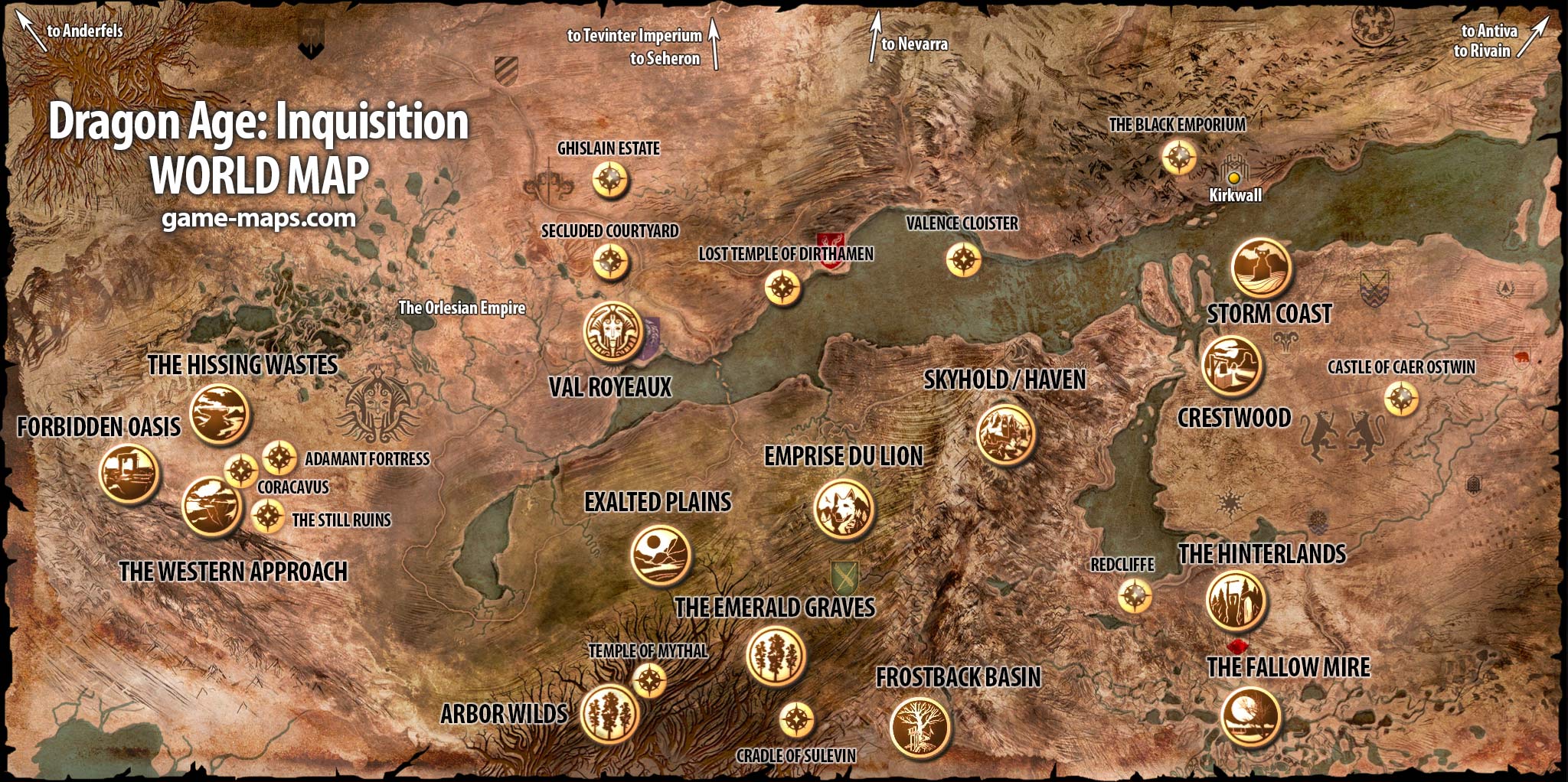

Dragon Age: Inquisition Maps
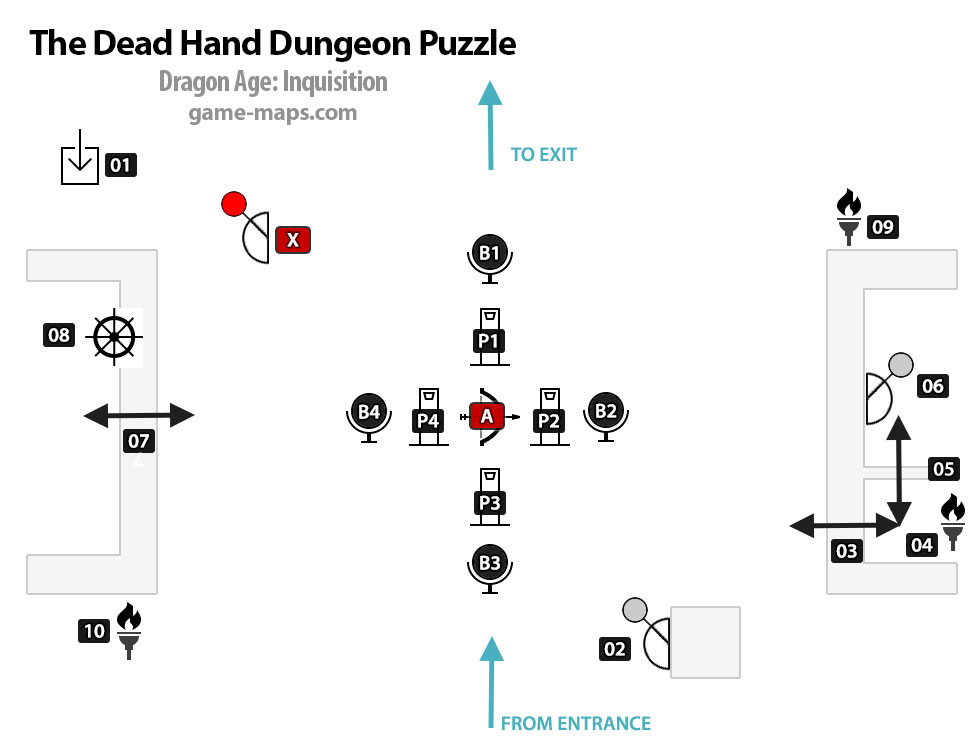
The Dead Hand Dungeon Puzzle
The Exalted Plains
The Dead Hand Dungeon Puzzle Dragon Age: Inquisition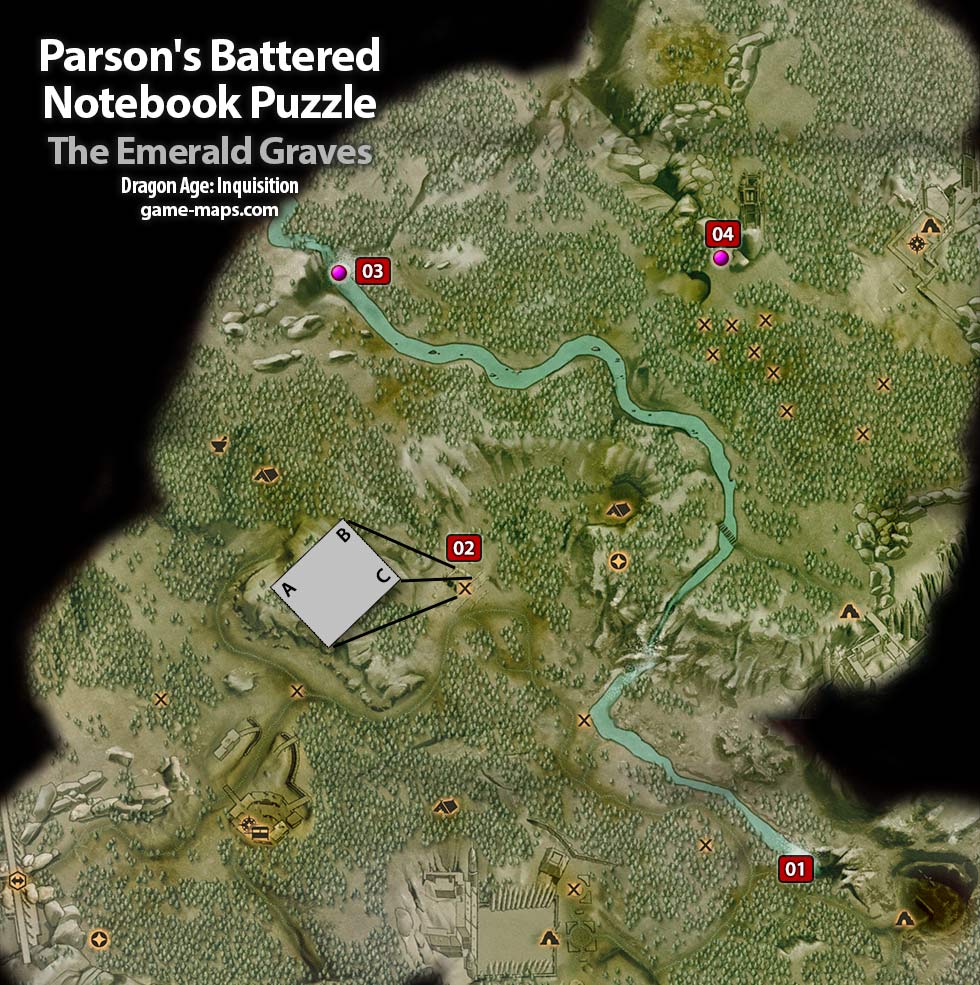
Parson's Battered Notebook - Lions Pavilion Torches Puzzle
The Emerald Graves
Parson's Battered Notebook - Lions Pavilion Torches Puzzle Dragon Age: InquisitionKnown Main Locations in World of Dragon Age: Inquisition
Adamant Fortress
Of all the decisions we Grey Wardens were forced to make over the lean years, withdrawing from the fortress of Adamant was perhaps the most difficult. It had been built as a bastion against darkspawn spilling out from the Abyssal Rift, a symbol of how we had done the impossible, pushing those creatures back into the shadows where they belonged. We kept the land safe from further encroachment, but as each new Age dawned, memories of our sacrifice became fainter. The entire Western Approach had become a wasteland, and thus the expense of maintaining the fortress became increasingly difficult to justify. There were no griffons to fill its weyrs, too few Wardens to man its battlements, too many good men and women killed by demons creeping through the thinning Veil... each visit of the Warden-Commander made it more apparent that Adamant had become a symbol of our decline. Even if darkspawn still emerged from the chasm, who would they threaten other than the Wardens themselves?
So in the dawn of the Blessed Age, we sealed the fortress's mighty gates. We left the great griffon statues to tarnish in the blowing sand, retreating to Montsimmard with a sense of loss and shame. I returned recently with a small expedition to retrieve supplies, surprised to see it still standing. The dwarves did well by us; I suspect Adamant will remain for ages to come... but should the Order ever return, they will find it difficult to resurrect. Only spirits roam its halls now, alongside the memories of those who gave their lives to protect us all from darkness.
From the journal of Veldin, Grey Warden of Orlais, 8:58 Blessed
The Anderfels
The Anderfels are a land of shocking extremes. It is the most desolate place in all the world, for two Blights have left great expanses of the steppes so completely devoid of life that corpses cannot even decay there - no insect or grub will ever reach them.
It is a land filled with wonders like the Merdaine, with its gigantic white statue of Our Lady carved into its face, her hands outstretched and bearing an eternal flame, or Weisshaupt Fortress, with its walls of living rock towering over the desolate plains below.
The Anders, too, are a people of extremes: the most devout priests and the most deadly soldiers, the poorest nation in the world and the most feared.
From In Pursuit of Knowledge: Travels of a Chantry Scholar by Brother Genitivi
Antiva
In the rest of the civilized world, it is common belief that Antiva has no king. I assure you, gentle readers, that this is untrue. The line of kings in Antiva has remained unbroken for two and a half thousand years - it is simply that nobody pays any attention to them whatsoever.
In truth, the nation is ruled by a collection of merchant princes. They are not princes in the literal sense, but heads of banks, trading companies, and vineyards. Their power is conferred strictly by wealth.
But Antiva is not primarily renowned for its peculiar form of government nor for its admittedly unparalleled wines. Antiva is known for the House of Crows. Since Antivans are well known for being good at everything but fighting, it is more than a little ironic that Antiva possesses the most deadly assassins in the world. Their fame is such that Antiva keeps no standing army; no king is willing to order his troops to assault her borders, and no general is mad enough to lead such an invasion. The attack would likely succeed, but its leaders would not see the day.
From In Pursuit of Knowledge: The Travels of a Chantry Scholar by Brother Genitivi
Arbor Wilds
Cruxis: For once, look to the elves for guidance. The Dalish shun the Arbor Wilds. When the people who would start a war over a single crumbling wall ignore a large elven ruin to the south, it bodes disaster. There is beauty and curiosity in the forest, such as trees that rise tall as towers, but those who travel too deep into them never return.
You asked if I could identify the elven architecture from the few existing sketches of the outer ruins. They have curious similarities to stonework found in Arlathan, so I would guess it is likely an old elven temple dating two, three hundred years before the Imperium. Anything else is conjecture that I fear will spurn you on in this folly.
Letter from a scholar of the Tevinter Imperium to Magister Cruxis, a mage of high standing who led a doomed expedition into the Arbor Wilds a year afterwards
Coracavus
On the edge of the empire, they erected a prison: Coracavus, the dark pit.
Far removed from the cultural heart of the Imperium, Coracavus held and meted out punishment to local peoples who denied Tevinter's claims to the region and to so-called "loyal" citizens who believed living on the fringes of civilization would grant them immunity from the Imperium's laws.
In a few cases, political prisoners who could not be sentenced with execution were sent to Coracavus instead. It was widely known that bribes bought nothing there and having the right name would not be rewarded with leniency. It's said that upon hearing their judgments, these individuals begged for death.
From A Brief History of the Imperium, Vol. 3 by Tyrus Altim
The Cradle of Sulevin
The Sulevin Blade: a sword with purpose.
When our people ruled the Dales, the blade's purpose was to defend our borders. When the Chantry marched against us, its purpose was to protect the innocent from those who would oppress us. More than one great hand wielded it in battle.
Yet few know its name. Fewer still will speak of it.
The Exalted March stretched on, and the Chantry's forces were nearing victory. A band of elves could not bear the loss. Desperation drove them to take the Sulevin Blade. A wish for vengeance gave the sword a new purpose.
"If the Chantry thinks us monsters," they thought, "then who are we to argue?"
They spilled innocent blood to power their magic. With it, they would defeat their enemies. Only - the ritual failed. The elves stood in the darkness, blood on their fingers, bodies at their feet. Then they heard the sound of footsteps. The elves' wish for vengeance was granted to those they had slaughtered. Spirits reached beyond the Veil and claimed the elves where they stood.
As for the Sulevin Blade, the sword lies broken in the accursed place where the elves attempted their ritual. Perhaps one day it will be reforged and given a new purpose. But at what cost? The location was lost long ago. Those who seek the sword never return. Some say they are claimed by the same spirits who were angered so long ago.
As much as we long for our past, there are some memories better left buried.
Story recited by Neria, First to Keeper Elindra of Clan Ralaferin, to Mathias Laren, Inquisition scribe
Crestwood
Crestwood is a small village of no real consequence to the lords and ladies who ride through on their way to Val Royeaux or Denerim. The people are glad for visitors, however. Residents tend livestock and grow what crops they can, but their chief income comes from trade.
I was dining alone at the local inn, which is quaintly perched on the top of a dam, when I overheard the barman mention tunnels beneath the village. I was surprised to learn that a vast cave system riddles the land surrounding Crestwood. The locals told me tales of strange noises and eerie lights, of entire expeditions swallowed by underground fissures, of screams in the dark that come from nowhere and return, just as swiftly, to nothing.
I scoffed, then went for a stroll around the area. The night was clear, and I was wending down a pleasant glade in the hills when I heard a rasping hiss. Dropping my walking staff, I spied an overgrown opening to a small cavern. Were those footsteps padding away into the dark I heard then, or a startled animal?
That night, I let the candle in my room burn longer than usual.
From the diary of a traveler from Val Chevin, dated three months before the start of the Fifth Blight
Deep Roads
There isn't a dwarf alive who remembers the Deep Roads as they once were. They were the network of tunnels that joined the thaigs together. To be honest, it isn't even right to give them such a simple term as "tunnels": they are works of art, with centuries of planning demonstrated in the geometry of their walls, with the statues of the Paragons that watch over travelers, with the flow of lava that keeps the Deep Roads lit and warm. The cloudgazers up on the surface talk of the Imperial Highway built by the magisters of old, a raised walkway that crossed thousands of miles, something that could only have been built by magic. Perhaps it is comparable to the Deep Roads, although we dwarves didn't need magic.
I suppose it doesn't matter anymore. The darkspawn rule the Deep Roads now. When Orzammar sealed off the entrances to the Deep Roads, abandoning everything that lay out there, we handed over the kingdom-that-was to those black bastards forever. To think that there are genlocks crawling over Bownammar now, tearing down our statues and defiling our greatest works! Corruption covers everything we built out there. Every dwarf who goes out and comes back says that it gets worse with each passing year, the foulness spread a little farther.
And the cloudgazers think the darkspawn are gone just because they aren't spilling out onto the surface? Huh. One day, when Orzammar is gone for good, they'll find out differently. Those darkspawn won't have anywhere else to go but up, and they'll do it. The surface folk will have themselves a Blight that will never end.
Transcript of a conversation with a member of the dwarven Mining Caste, 8:90 Blessed
The Emerald Graves
Our people call this place the Emerald Graves. Long ago, before the fall of the Dales, a tree was planted for every warrior who pledged themselves to the guardianship of the Dales. Together, these warriors were the Emerald Knights of Halamshiral, and the forest of their trees was named the Emerald March.
When the humans began encroaching once again on our borders, the Emerald Knights banded together to protect us from the incursion. But the humans were many, and their Chantry powerful, and they eventually conquered the Dales. The knights fought in defense of our land, and almost all perished. The trees that once represented a mighty army were now living symbols of sacrifice - the Emerald Graves.
I hear that most humans in Orlais do not call this place by its true name. They find it an inauspicious one and refer to the forest only as the Greatwood. They refuse to see anything but wood and moss and leaves, and hope to remain ignorant of the blood that was spilled. But we of the People remember. We feel the weight of what was lost, and we see, not trees, but lives given for freedom.
As told by Keeper Gisharel of the Ralaferin clan
Emprise du Lion
The ancient name of these craggy highlands has long been lost to time. When the first Valmont emperor was crowned in the Exalted Age, the mountains were renamed Emprise du Lion to honor the House of Valmont, which bears a lion upon its crest.
Wandering through these remote hills, I discovered remnants of a forgotten past, mingled delightfully with signs of the present. Charming villages dotted the landscape, and, scattered among them, relics of the lost elven nation. Young women sold wild berries at a market nestled in the shadow of a sinister, crumbling fortress, which may once have been the seat of a Dalish lord. Children played in fields, watched over by the silent statues of gods whose names they did not know. I walked quiet lanes bordered with wildflowers, the high arches of an ancient bridge soaring above me, majestic even in their ruin.
Sadly, my time in the mountains was short, and I soon continued on to Halamshiral. I found myself thinking back on the Emprise du Lion, however, and how gracefully she bore the passing of the ages. I wondered what the future held and dreamed of how it might leave its mark. Whatever comes can only add to her beauty: delicate lines on the face of a gentlewoman, which speak of a life well-lived.
From In Pursuit of Knowledge: The Travels of a Chantry Scholar by Brother Genitivi
The Exalted Plains
It is appropriate that we pick the Exalted Plains as our field of battle. It was here, centuries ago, that the Dalish kingdom met its bitter end. The holdouts of the elven army making their last stand, refusing to surrender, against the champions of Andraste: the templar, the sister, and the nobleman patron. The champions' cause was just, and their faith led them to victory. The plains were henceforth called "Exalted."
Someone once said that these fields are characterized by equal measures of beauty and strife. This description will hold true for the foreseeable future. The strife we bring to the Dales will be quickly forgotten, however, if we fight hard and fight well and earn a definitive victory. Let the knowledge that you strike in the name of the true emperor encourage and guide you. Truth and righteousness prevailed on the plains, long ago. Maker willing, it will again.
A message from Marshal Bastien Proulx to his soldiers before battle was joined
The Fade
The study of the Fade is as old as humankind. For so long as men have dreamed, we have walked its twisting paths, sometimes catching a glimpse of the city at its heart. Always as close as our own thoughts, but impossibly separated from our world.
The Tevinter Imperium once spent vast fortunes of gold, lyrium, and human slaves in an effort to map the terrain of the Fade, an ultimately futile endeavor. Although portions of it belong to powerful spirits, all of the Fade is in constant flux. The Imperium succeeded in finding the disparate and ever-shifting realms of a dozen demon lords, as well as cataloging a few hundred types of spirits, before they were forced to abandon the project.
The relationship of dreamers to the Fade is complex. Even when entering the Fade through the use of lyrium, mortals are not able to control or affect it. The spirits who dwell there, however, can, and as the Chantry teaches us, the great flaw of the spirits is that they have neither imagination nor ambition. They create what they see through their sleeping visitors, building elaborate copies of our cities, people, and events, which, like the reflections in a mirror, ultimately lack context or life of their own. Even the most powerful demons merely plagiarize the worst thoughts and fears of mortals, and build their realms with no other ambition than to taste life.
From Tranquility and the Role of the Fade in Human Culture by First Enchanter Josephus
The Fallow Mire
I spent the last week in the Fallow Mire. The bog stretches forever, and it's slow riding at night when the mists get thick. You can still travel along the old roads, and there's enough good hunting to make the trip worthwhile. Fish, birds, even a few harts.
There's one thing to look out for, though. When anything dies in the water, the mire preserves it. I was stalking a magnificent buck when a corpse clawed out of the water at me. I'm not afraid to say I ran. No rack of antlers is worth fighting a demon. My cousin in Fisher's End thought it was funny. Says he has to look out for undead every time he goes outside the village! I don't know how he stands it.
Diary of a hunter from Denerim
Ferelden After the Blight
One need only stroll through the Denerim market to appreciate Ferelden's resilience. You would be hard-pressed to believe that darkspawn ravaged the city within our lifetime. Scars remain for the people who lived through it, but life moves forward.
Now children play in the streets - children for whom the Blight is a story their parents tell. I once heard a small boy ask what a darkspawn was; to him, it was only a word he heard from the older youths. We teach that "a learned child is a blessing upon his parents and unto the Maker." Andraste forgive me, but I felt joy at his smiling ignorance.
Fereldan Culture
The Fereldans are a puzzle. As a people, they are one bad day away from reverting to barbarism. They repelled invasions from Tevinter during the height of the Imperium with nothing but dogs and their own obstinate disposition. They are the coarse, willful, dirty, disorganized people who somehow gave rise to our Prophet, ushered in an era of enlightenment, and toppled the greatest empire in history.
There are few things you can assume safely in dealing with these people: First, they value loyalty above all things, beyond wealth, beyond power, beyond reason. Second, although they have nothing in their entire country which you are likely to think at all remarkable, they are extremely proud of their accomplishments. Third, if you insult their dogs, they are likely to declare war. And finally, the surest sign that you have underestimated the Fereldans is that you think you have come to understand them.
Empress Celene I of Orlais, in a letter to her newly appointed ambassador to Denerim
A Tale of the Frostbacks
Even mountains had a heart once. When the world was young, Korth the Mountain-Father kept his throne at the peak of Belenas, the mountain at the center of the world, from which he could see all the corners of earth and sky. And he saw strong men become weak, brave men grow cowardly, and wise men turn foolish for love.
Korth devised a plan that he might never be betrayed by his own heart, by taking it out and hiding it where no soul would ever dare search for it. He sealed it inside a golden cask, buried it in the earth, and raised around it the fiercest mountains the world had ever seen, the Frostbacks, to guard it.
But without his heart, the Mountain-Father grew cruel. His chest was filled with bitter mountain winds that shrieked and howled like lost souls. Food lost its flavor, music had no sweetness, and he lost all joy in deeds of valor. He sent avalanches and earthquakes to torment the tribes of men. Gods and men rose against him, calling him a tyrant, but with no heart, Korth could not be slain. Soon there were no heroes left, either among men or gods, who would dare challenge Korth.
The Lady of the Skies sent the best of her children - the swiftest, the cleverest, and strongest fliers - to scour the mountains for the missing heart, and for a year and a day they searched. But sparrow and raven, vulture and eagle, swift and albatross returned to her with nothing.
Then the ptarmigan spoke up and offered to find the god-chief's heart. The other birds laughed, for the ptarmigan is a tiny bird, too humble to soar, which spends half its time hopping along the ground. The Lady would not give the little creature her blessing, for the mountains were too fierce even for eagles, but the ptarmigan set out anyway.
The little bird traveled deep into the Frostbacks. When she could not fly, she crawled. She hugged the ground and weathered the worst mountain winds, and so made her lonely way to the valley where the heart beat. With all the god's terrible deeds, the heart was far too heavy for the tiny bird to carry, so she rolled it, little by little, out of the valley and down a cliff, and when the golden cask struck the earth, it shattered. The heart was full almost to bursting, and the pain of it roused the mountain god to come see what had happened.
When Korth neared his heart, it leapt back into his chest, and he was whole again. Then Hakkon Wintersbreath bound Korth's chest with three bands of iron and three bands of ice, so it could never again escape. And all the remaining gods named the ptarmigan honored above even the loftiest eagles.
The Ptarmigan: An Avvar Tale," from Ferelden: Folklore and History by Sister Petrine, Chantry scholar
Halamshiral
After the glorious reclamation of the Dales, the elven capital lay empty and in ruins for years, a haven for bandits and highwaymen and all manner of miscreants. The land lay unused until the Exalted Age, when Alphonse Valmont, the very Lion himself, declared that a palace should be built there in honor of the valiant actions of his brothers in besting the armies of false Emperor Xavier Drakon. Originally called Chateau Lion, it was designed as a grand retreat for the emperor's brothers and their families.
The city of Halamshiral grew around the palace. The first records of its existence appear in the Storm Age, when Emperor Cyril granted the title of marquis to Ser Reginald Montclair for "administration of Halamshiral."
An elven uprising destroyed Chateau Lion in the Blessed Age. When Emperor Judicael I rebuilt it, he named the new retreat the Winter Palace. It was designed more for the emperor and his immediate family than for any cadet branches of House Valmont, and became the heart of the Imperial Court in the darkest months of winter.
An excerpt from Architectural History of Orlais, Volume 1 by Elodie Ferrneau
Haven
I would like to speak to you of Haven - the village in the Frostbacks, close to the Temple of Sacred Ashes. We are all aware of its past. It was home to the "Disciples of Andraste," as they called themselves. Descended from the people who built the temple itself, they had strayed, over years of isolation, from their once-noble roots to become dragon worshippers. After the Hero of Ferelden discovered the Temple of Sacred Ashes, which the Disciples guarded jealously, what remained of the cult moved on, and Haven was abandoned to the ice and the snow.
I passed through Haven on my pilgrimage to see the Temple of Sacred Ashes. There was a storm, and I took shelter in the hall of Haven's chantry. Though they were dusty from neglect, the walls of that lonely place were strong and shielded me from the biting winds. Peace came upon me, and my eyes were opened to Haven's incredible beauty. It could not be overcome by the pain and the horror of the past. It could not be masked by decay and disuse. It would not be forgotten.
Haven is precious to Orlais, to the Chantry, and to the Sunburst Throne for its historical and religious significance. It is my will that Haven be restored, rededicated to the service of Andraste, and preserved for the ages. Let it be a sanctuary for the pilgrims who seek out the Temple of Sacred Ashes. May they rest here beneath the cold, bright skies. May the glory of the Maker be revealed to them, as they gaze upon the grey peaks that are the work of His hand. Now and forever more, let this be a Haven for the faithful.
From a speech by Divine Justinia V in 9:35 Dragon
The Hinterlands
My Lord Arl Teagan,
I retired to the Hinterlands for peace and quiet away from the politics, and because the wide open spaces were perfect to let my horses run. Instead, the war between the mages and the templars has turned your beautiful hills into a series of burning battlefields.
The farmers who live in the Hinterlands are good folk. Many of them left Redcliffe village because they couldn't bear to be there anymore, not after the Blight and the walking dead left so many bad memories. Now we've got apostates running around setting fire to anyone who looks at them sideways, and templars looting houses and cutting down those who protest as mage sympathizers.
My wife Elaina sent off our field hands to stay with her family in the east, but there are a lot of poor people here with nowhere to go. We get more refugees every day: this village attacked by mad mages or that farmstead burned to the ground by templars who can't tell a hoe from a staff.
I suppose you're stretched thin, but anything you can do to lessen the burden of these poor folk would be much appreciated. I'll do as I can, and if your men need better mounts, say the word.
Best of luck to you, my lord. Remember not to let Duchess puff out her gut when you saddle her.
Yours in service, Dennet
A letter from Redcliffe's former horsemaster to Arl Teagan of Redcliffe (undelivered)
The Hissing Wastes
Felicity:
You're chasing nonsense. Even if there were an old city buried in the Hissing Wastes, what makes you think the university would send you there on the chance you'll dig up an interesting slab of rubble? I skirted the edge of it once. If the wildlife isn't venomous, it's filled with fangs. The days bake, the nights freeze, and the only other souls you meet have even worse reasons for being there than you do. I haven't even mentioned that dragons like to nest in the rocks. (Ask Alphonse how he got the scar on his arm. He'll tell you.)
Leave that desert to the treasure hunters, my dear. Our empire is full of ruins. Let us find one in a more hospitable climate, such as Montsimmard in the spring.
Letter from a third-year university student in Val Royeaux to her younger sister
The City-State of Kirkwall
From the office of Provisional Viscount Bran of Kirkwall: Please circulate to all functionaries. Swap in the names of our newest "benefactors" and let us be done with their endless attempts at cleverly veiled intentions.
To the forces and/or diplomatic representatives of (copy their names and meaningless honorifics here),
Thank you for your kind offer of (tiresome insistence), but I assure you that we are quite inundated with similar inquiries at the moment. It falls to me, as provisional viscount, to draw your ire, and for that, I sincerely apologize. I assure you that I do not wish this to be the case: neither the refusal, nor my place in the delivery of it. Perhaps you will join the chorus of those questioning whether I possess the authority to deny you? Rest assured, when arrows are still in the air, it is common for those who desire stability but who lack the will to fight for it to impose the opportunity onto others deemed expendable. And as I was one of the few remaining who knew the relevant protocol, representing "freed" Kirkwall apparently falls to me. Or, rather, with the role left open, I was pushed in by unpopular vote. In either case, there is falling, but the precedent is well tested.
I expect the previous in no way will deter you from continuing your aggressive inquiries. Kirkwall has always been a valuable port, the nexus of nearly all trade that flows between the Free Marches and Ferelden. It has changed hands many times before, and I expect (posturing leader's name) would see it do so again. On this point. I would urge caution for a number of factors have deviated from the historical norm.
Nevarra
The fourth time I attempted to cross the border into Nevarra from Orlais and was turned back by chevaliers, I decided to take the more roundabout path: a ship back to Ferelden, and then another to Nevarra. The outcome was more than worth the trouble.
The whole country is filled with artistry, from the statues of heroes that litter the streets in even the meanest villages to the glittering golden College of Magi in Cumberland. Perhaps nowhere is more astonishing than the vast necropolis outside Nevarra City. Unlike most other followers of Andraste, the Nevarrans do not burn their dead. Instead, they carefully preserve the bodies and seal them in elaborate tombs. Some of the wealthiest Nevarrans begin construction of their own tombs while quite young, and these become incredible palaces, complete with gardens, bathhouses, and ballrooms, utterly silent, kept only for the dead.
From In Pursuit of Knowledge: The Travels of a Chantry Scholar by Brother Genitivi
The Forbidden Oasis
I met Bayard in Val Firmin. From here, we will travel with the miners to the Western Approach. I already miss the sound of your voice, but the contract they offered will provide for us, and what is a year if I know you are waiting at the end of it?
Bayard says the miners call the place the "Forbidden Oasis." I feared perhaps the water was poisonous - you hear of such things - or that the area was home to one of the beasts in Joaquim's books. Bayard simply laughed and told me not to worry so much. When I asked how the oasis earned its dramatic name, Bayard replied, "Don't ask about the door."
Excerpt from a letter written by Saul Didot to his wife, Lynette, dated 9:38 Dragon. No further correspondence was sent.
The Orlesian Empire
There are many lords and ladies in Val Royeaux.
And I mean this literally. Once, the system of noble titles in Orlais was labyrinthine: there were barons and baronnes and baronets and sur-barons and a horde of others, each with its own origins and its own nuances of comparison. The Orlesian aristocracy is ancient and much given to competition. All the nobility play the Grand Game, as it is known, whether they wish to or not. It is a game of reputation and patronage, where moves are made with rumors and scandal is the chief weapon. No gentle game, this. More blood has been drawn as a result of the Grand Game than any war the Orlesians have fought. Of this, I am assured by almost every gentleman here.
As far as titles went, everything changed with the coming of Emperor Drakon, who established the Orlesian Empire as it exists now, and who created the Chantry. There is no more venerated figure in Orlais; in Val Royeaux, the statue of Drakon stands as tall as the statue of Andraste. Drakon determined that the Grand Game was tearing Orlais apart, so he abolished all titles besides his own, and lord, and lady.
I am told, with some twittering amusement, that this action did not end the Grand Game as Drakon had intended. Now the lords and ladies collected unofficial titles rather than official ones, such as "the exalted patron of Tassus Klay" or "uncle to the champion of Tremmes." It is a headache to remember such titles, and one winces to think of the poor doormen at the balls who must rattle them off as each guest enters the room.
The aristocracy is different from Ferelden in other ways, as well. The Orlesians' right to rule stems directly from the Maker. There exists neither the concept of rule by merit nor the slightest notion of rebellion. If one is not noble, one aspires to be - or at the least aspires to be in the good graces of a noble, and is ever watching for a way to enter the patronage of those better placed in the Grand Game.
And then there are the masks. And the cosmetics: I have not seen so much paint since the kennels at Highever. But that is another story.
From Beyond the Frostbacks by Bann Teoric of West Hill, 9:20 Dragon
Redcliffe
King Calenhad Theirin once famously declared, "The fate of Redcliffe is the fate of all Ferelden." Certainly, the castle is the first and last defense for the sole land route into Ferelden, and the country has never fallen to any force that did not first capture Redcliffe.
The castle, which despite being three times captured is popularly described as "unassailable," also guards one of the largest and most prosperous towns in Ferelden. Redcliffe village is well situated near the mountain pass to Orzammar and the Orlesian border, and so serves as a center of foreign trade. For these reasons, Redcliffe is accounted an arling despite the smallness of the domain.
The inhabitants of Redcliffe village are primarily fishermen or merchants who ship dwarven goods through the pass from Orlais to Denerim. When the entire village smells of smoked fish on certain late-autumn mornings, the merchants in their finery do their utmost to pretend otherwise.
From In Pursuit of Knowledge: The Travels of a Chantry Scholar by Brother Genitivi
Rivain
Nowhere in my travels, not in the heart of the Imperium nor the streets of Orzammar, have I felt so much an outsider as in Rivain.
The Chant of Light never truly reached the ears of these people. The years they spent under the thumb of the Qunari left most of the country zealous followers of the Qun. But resistance to the Chant goes deeper than the Qunari War. The Rivaini refuse to be parted from their seers, wise women who are in fact hedge mages, communicating with spirits and actually allowing themselves to become possessed. The Chantry prohibition against such magical practices violates millennia of local tradition.
From In Pursuit of Knowledge: The Travels of a Chantry Scholar by Brother Genitivi
Caer Bronach
King Brandel erected Caer Bronach in 8:26 Blessed, intending the fort as a stopover garrison for Fereldan soldiers fighting Orlesian invaders. The village of Crestwood takes its name from the fort's first captain, Ser Venar Crestwood, who held Caer Bronach longer than anyone thought possible against a vanguard of the Orlesian army.
When the fort's defeat seemed inevitable, Ser Crestwood opened the gates, holding a flag of truce, and challenged every chevalier in the Imperial army to a duel. Amused, one Orlesian officer accepted the offer; Ser Crestwood swiftly cut him down. Eight more followed, honor and the watching soldiers forcing them to fight Ser Crestwood one on one. The tenth challenger finally managed a fatal blow, only because Ser Crestwood had slowed due to blood loss from previous injuries.
Impressed by Ser Crestwood's tenacity and endurance, the remaining officers left the small village around the fort untouched as the Orlesians made for the capital, sparing hundreds of innocent lives.
From Notable Fortresses, Castles, Towers, and Other Edifices of Interest in Ferelden, by Henry Lannon
Seheron
The goal is fear.
The Qunari in Seheron's markets must fear that everyone who serves their food is a rebel looking for a chance to slip poison onto a Qunari's plate. The rebels must fear that every farmer they pass in the fields is a Ben-Hassrath spy ready to bring soldiers running. And the commoners, the peasants? They must fear everyone. They see rebels light fires that kill Qunari and commoner alike. They see Ben-Hassrath arrest commoners who all know are innocent. When these events do not occur naturally, it is our duty to catalyze the process.
Only when the commoners of Seheron fear the rebels and hate the Qunari will the Imperium be seen as the preferable option. The actions we take here may seem cruel, but to succeed, we must agitate until all of Seheron hates both the rebels and the Qunari for their actions.
Only when the people are broken can we save them. Only when they fear all others will they accept the aid of the Imperium. Any good soldier would kill ten men to save twenty. We must bring terror to Seheron so that we might one day bring peace.
An excerpt from a training manual given to Tevinter operatives joining the Siccari, whose existence has been officially denied
The Still Ruins
24 Harvestmere - A pair of hunters arrived today from the Western Approach. They carried a third between them, unconscious. The hunters found the man wandering the Approach. He collapsed at their feet before they could learn his identity. The rough stories you hear, I'm surprised they didn't slit his throat and call it mercy. Instead, they lay him alongside their prizes and took him from that place. Serise forced him to swallow water with a mixture of herbs. Alain says he will show me how to make it tomorrow.
26 Harvestmere - Serise and Alain left the patient to my care. They believe the man will die, so what harm could I do? - Still, I prepare the herbs with care. I do what I can to make him comfortable. The man murmurs in his sleep. Something about there being no wind. I would open the window, but the air is chill, and I fear it would weaken him.
5 Firstfall - My patient opened his eyes. - "Varghest took the rest. Then I found it. Everything so still. There was no wind." He seemed quite intent. - "In the Western Approach?" I asked. - "Oh, a soldier..." - This last about the figurine I placed on his bedside table for Satinalia. Foolish, but I thought it might cheer him.
8 Firstfall - My patient took a simple meal. Speaking wearies him, but he tried. - "Everything was so still. There was no wind." - I told him that sounded peaceful. His eyes widened in fear. - "The demons were still there." - I tried to comfort him, but he was desperate to explain the disturbing images in his mind. Later, I saw him staring at the little soldier. "They couldn't move," he murmured. I said I could take the toy away, but he shook his head.
20 Firstfall - Serise and Alain declared my patient well enough to travel. He left before I returned from visiting my sister. - I suspect his "still ruins" were a delusion brought on by his trials in the Approach, but I will never know. I wish I could have said goodbye. Serise says he took the soldier with him. Perhaps it was a comfort after all.
From the journal of Nicolette Envers, healer's apprentice
The Storm Coast
I cannot say whether the Storm Coast receives more inclement weather than any other stretch of northern Fereldan coastline. That hasn't stopped the region from boasting more than its fair share of tragic tales. If all are to be believed, rich merchant ships blanket the depths due to the follies of their proud captains. The infamous - and likely fictional - pirate, Denel of Salle, gave up the sea to become a Grey Warden while standing on these shores, and countless young women pine for grooms lost to the waves.
I witnessed nothing so fanciful on my brief sojourn to the coast. However, the area is sparsely populated, and as I watched the Waking Sea strike the shore, I could see why such tales are born.
From In Pursuit of Knowledge: Travels of a Chantry Scholar by Brother Genitivi
Temple of Sacred Ashes, Rediscovered
According to legend, the Sacred Ashes of Andraste were carried out of the Imperium by Havard, disciple of Our Lady. Wounded by Tevinter soldiers when he tried to stop Andraste's capture, Havard was too late in coming to Minrathous to stop the execution. All he found was her ashes, left out in the elements. As soon as Havard touched them, Andraste appeared in a vision.
"Rise," she said, "Aegis of the Faith. The Maker shall never forget you so long as I remember."
The Aegis of the Faith, so named by our Prophet herself, stood at her word and found his wounds healed and his spirit renewed. He gathered the ashes of Andraste and returned to the lands of the Alamarri tribes, which are now Ferelden. It's said that Andraste's song led him to a holy site, where Havard and his followers built a temple to house her remains.
There the legend ends. For centuries, men searched for the Temple of Sacred Ashes, finding only rumors and tall tales. Chantry scholars concluded that there was no temple. There were no Sacred Ashes. It was all a myth, allegory intended to inspire and feed the fire of faith.
Then the Hero of Ferelden came. Seeking to cure a dying arl with the miraculous powers of the ashes, the Hero, with the help of renowned scholar Brother Ferdinand Genitivi, traced the steps of the ancients and came to a remote ruin, high in the Frostback Mountains. There, the Urn of Sacred Ashes waited, as the legend said it would.
The Temple of Mythal
Once again, Genitivi is completely at odds with reality! Ancient elven "temples" were no simple shrines. Extensive digging shows that buildings radiated out of the main edifice, much like a city wrapped around a palace. Indeed, these temple complexes must have been cities once, with a veritable army of functionaries running them. Each cult had different rituals, ablutions, and prayers to their chosen patron that ran all hours of the day. The time and effort devoted to them must have been staggering.
Perhaps it's best we have lost knowledge of these pagan rites. The "deities" that the old elves worshipped, if they existed at all, were clearly demons masquerading as higher powers. One shudders to think of what went on before their thrones.
From an essay by Atronus of Antiva, scholar and naturalist to the Antivan royal court
The Tevinter Imperium
For good or ill, the Imperium has put its stamp on Thedas forever.
The old Imperial Highway is still in use across most of Thedas. The ruins of Tevinter fortresses and centers of magical study still litter our landscape, long after the glory of the Imperium dimmed. But the influence of that ancient empire goes deeper than this. Without Tevinter, there would have been no Blights, no Andraste, no Chantry. Every aspect of our world would be altered.
The might and majesty of the Imperium may have faded, but it still makes its presence known, even in the most distant corners of Thedas. Every child has been brought up on stories of Tevinter as it is now: a decadent nation, ruled by the Archon and his court of magisters - great, and no doubt corrupt, mage-lords. Their Chantry a mockery of our own, their Black Divine a man chosen from the ranks of the Minrathous Circle of Magi. The Maker's most hallowed law, "Magic exists to serve man, and never to rule over him," perverted. Mages in the Imperium say their most sacred duty is to serve man, and they serve best by wielding political power.
And the worst, that which Blessed Andraste must weep to see: all of it is built on a foundation of slavery. While most nations forbid the buying and selling of slaves within their own borders, nearly everyone ships people to the Imperium for sale, skirting the prohibitions against such atrocities and feeding the Imperium's endless hunger for bodies: to fight the Qunari, to work the mines and quarries, to build the palaces of the magisters, to sweep the crumbling streets and turn the middens and serve at the whim of their mage overseers.
From Black City, Black Divine: A Study of the Tevinter Imperium by Sister Petrine, Chantry scholar
Caer Oswin
I worry about Loren daily. Ever since the death of his wife and son in Highever at the onset of the Blight, he retreats further and further into reclusion.
Almost no one is permitted to come to Caer Oswin. The last time I managed to see him, it was only because I bullied my way into the castle and insisted his strange new guards take me to him. And I say "strange new guards" for a reason: almost all the Oswin retainers have been sent away. These men didn't wear Bann Loren's colors, and they struck me more as prison wardens than as protectors. Loren himself was pale and almost delirious. I begged him to see a physic, and he promised he would, but I doubt he ever did.
The guards ushered me out in a hurry, and the last time I returned, I was not even allowed past the gate. It's been months since anyone saw Loren at all. I fear the worst has happened, yet I can prove nothing. All I can do is pray the rest of the Bannorn take notice and act before a good man is lost.
From a letter by Bann Alfstanna Eremon, Dragon 9:40
The Black Emporium
It is a myth, of course, nothing more.
Tales of a mysterious underground shop run by an immortal - perhaps undead - proprietor who peddles impossible and implausible goods have circulated for decades among the templars. Now and then, a zealous or curious knight will go looking for the place to no avail. Stories place the Black Emporium in Kirkwall's Darktown, the sewers of Val Royeaux, in the back of an empty boathouse in Llomerryn, at the top of a tower in Marnas Pell, and hidden beneath the skirts of the giant statue of Andraste at the Merdaine.
No reputable source has ever found it and none ever will, because it does not exist.
You will, of course, hear the standard justifications: it appears only to the worthy, it appears only to the invited, it is hidden by blood magic, it exists only in the Fade. Rubbish. There is no magic that can hide an entire shop full of trinkets from the eyes of a Seeker of Truth. And I am not just saying that because I searched for six months and didn't find it; shut up, Tristan.
From a letter by Seeker Benedict to Divine Justinia V.
The Western Approach
Once these wastes were a land of plenty. Can you believe it? The rain came north over the Gamordan Peaks, turning the plains green and verdant for three months of the year. Eight hundred years ago, that changed. During the Second Blight, darkspawn spilled out of an enormous crack in the earth, corrupting it with their foul blood... and it never recovered, even after they were driven back underground. The Grey Wardens built Adamant Fortress to stand watch over that chasm, but eventually even they abandoned it to the wind and the biting sand.
What few of us eke out a living in this Maker-forsaken place do so knowing that any number of deaths await us: darkspawn raids, dragons, bandits - not to mention starvation from the lack of water and game. If we stay, it is because we know there are treasures buried in the bones of this place, ruins from the time when Tevinter ruled, and even earlier. We pass tales around our campfires of the things we have seen shrouded in the dust storms. My favorites are the ones about relics that could restore the Western Approach once more... but I don't believe them. Truth be told, on nights when the wind is calm, I can stand on a hilltop and see for miles in the moonlight over a stark beauty of which no other Orlesian can claim to know the equal. On those nights, I hope it will never change.
From Lands of the Abyss by Magistrate Gilles de Sancriste
Map Legend for Dragon Age: Inquisition
![]() Location - This is in game location. The sequence of numbers shows suggested order of visiting locations.
Location - This is in game location. The sequence of numbers shows suggested order of visiting locations.
![]() Starting Quest Location This is location with quest giver. It can be item, person or place.
Starting Quest Location This is location with quest giver. It can be item, person or place.
![]() Inquisition Camp - Heals, restock potion, place to rest, change party members, use it to fast travel. Setup camps as fast as you can.
Inquisition Camp - Heals, restock potion, place to rest, change party members, use it to fast travel. Setup camps as fast as you can.
![]() Landmark - POIs (Points of Interest). Visit and claim to complete collections.
Landmark - POIs (Points of Interest). Visit and claim to complete collections.
![]() Shop Traders & Merchants, to buy / sell items.
Shop Traders & Merchants, to buy / sell items.
![]() Crafting Station - Here you can create or modify Weapons, Armor, Accesories, Runes and Potions.
Crafting Station - Here you can create or modify Weapons, Armor, Accesories, Runes and Potions.
![]() Fade Rift - You can close Rifts using your ability. Rifts grows in difficulties in following locations. Closing a Fade rift rewards with amount of Power. There are a total of 81 rifts in Thedas.
Fade Rift - You can close Rifts using your ability. Rifts grows in difficulties in following locations. Closing a Fade rift rewards with amount of Power. There are a total of 81 rifts in Thedas.
![]() Astrarium - Astrariums are ancient relics of Tevinter origin that allow the viewing of constellations in the stars. Solve Astrarium puzzles to reveal secret location with treasure.
Astrarium - Astrariums are ancient relics of Tevinter origin that allow the viewing of constellations in the stars. Solve Astrarium puzzles to reveal secret location with treasure.
![]() Ocularum - Use Ocularums to reveal locations of magical Shards. Shards can be used in Forbidden Oasis Location.
Ocularum - Use Ocularums to reveal locations of magical Shards. Shards can be used in Forbidden Oasis Location.
![]() Dungeon Entrence - Entrence to Cave, Dungeon, Crypt, Underground.
Dungeon Entrence - Entrence to Cave, Dungeon, Crypt, Underground.
![]() Locked Door - This kind of Locked Doors require Special Key or "Deft Hands, Fine Tools" Inquisition Perk
Locked Door - This kind of Locked Doors require Special Key or "Deft Hands, Fine Tools" Inquisition Perk
![]() Fast Travel - You can travel to this points pointing on world map.
Fast Travel - You can travel to this points pointing on world map.
![]() Area Exit This is Exit to main map
Area Exit This is Exit to main map
![]() Mosaic Piece Collect mosaic for Collections. Mosaic sets are Sacrifice, Invasion, The Fall, Archdemon and Freed Are Slaves. Each Mosaic set has 12 pieces.
Mosaic Piece Collect mosaic for Collections. Mosaic sets are Sacrifice, Invasion, The Fall, Archdemon and Freed Are Slaves. Each Mosaic set has 12 pieces.
![]() Bottle of Thedas Collect Bottles for Collections. There are 29 bottles that can be collected.
Bottle of Thedas Collect Bottles for Collections. There are 29 bottles that can be collected.
![]() Inquisition Agent Here you can hire new Inquisition Agent.
Inquisition Agent Here you can hire new Inquisition Agent.
![]() Party Member Here you can recruit new Party Member
Party Member Here you can recruit new Party Member
![]() Secret - Use Search ("V" on PC) to reveal secrets. Sometimes you need to use search key few times.
Secret - Use Search ("V" on PC) to reveal secrets. Sometimes you need to use search key few times.
![]() Codex Entry It can be book, letter, place, item. After you collect 250 codex entries you become Loremaster.
Codex Entry It can be book, letter, place, item. After you collect 250 codex entries you become Loremaster.
![]() Specials - Important place, interesting place, easy to be missed, just look around carefully.
Specials - Important place, interesting place, easy to be missed, just look around carefully.
![]() Ballad Collection - Song Lyrics or sung song for Collection. There are 21 songs to collect.
Ballad Collection - Song Lyrics or sung song for Collection. There are 21 songs to collect.
![]() Logging Stand - for Resource Requisition Quest, used for crafting Skyhold improvements.
Logging Stand - for Resource Requisition Quest, used for crafting Skyhold improvements.
![]() Quarry - for Resource Requisition Quest,, used for crafting Skyhold improvements.
Quarry - for Resource Requisition Quest,, used for crafting Skyhold improvements.
![]() Artifact - Artifact to Activate for Solas. When activated they strengthen the Veil in the close area.
Artifact - Artifact to Activate for Solas. When activated they strengthen the Veil in the close area.
![]() Glyph - Use Veilfire to obtain Rune
Glyph - Use Veilfire to obtain Rune
![]() Keep - Tou have to defeat enemy and claim this keep for Inquisition, then it will be your Camp.
Keep - Tou have to defeat enemy and claim this keep for Inquisition, then it will be your Camp.
![]() Operation - You have to perform Operation here.
Operation - You have to perform Operation here.
![]() Dragon - Dragon for High Dragon Collection. There are 10 high dragons in Dragon Age: Inquisition.
Dragon - Dragon for High Dragon Collection. There are 10 high dragons in Dragon Age: Inquisition.
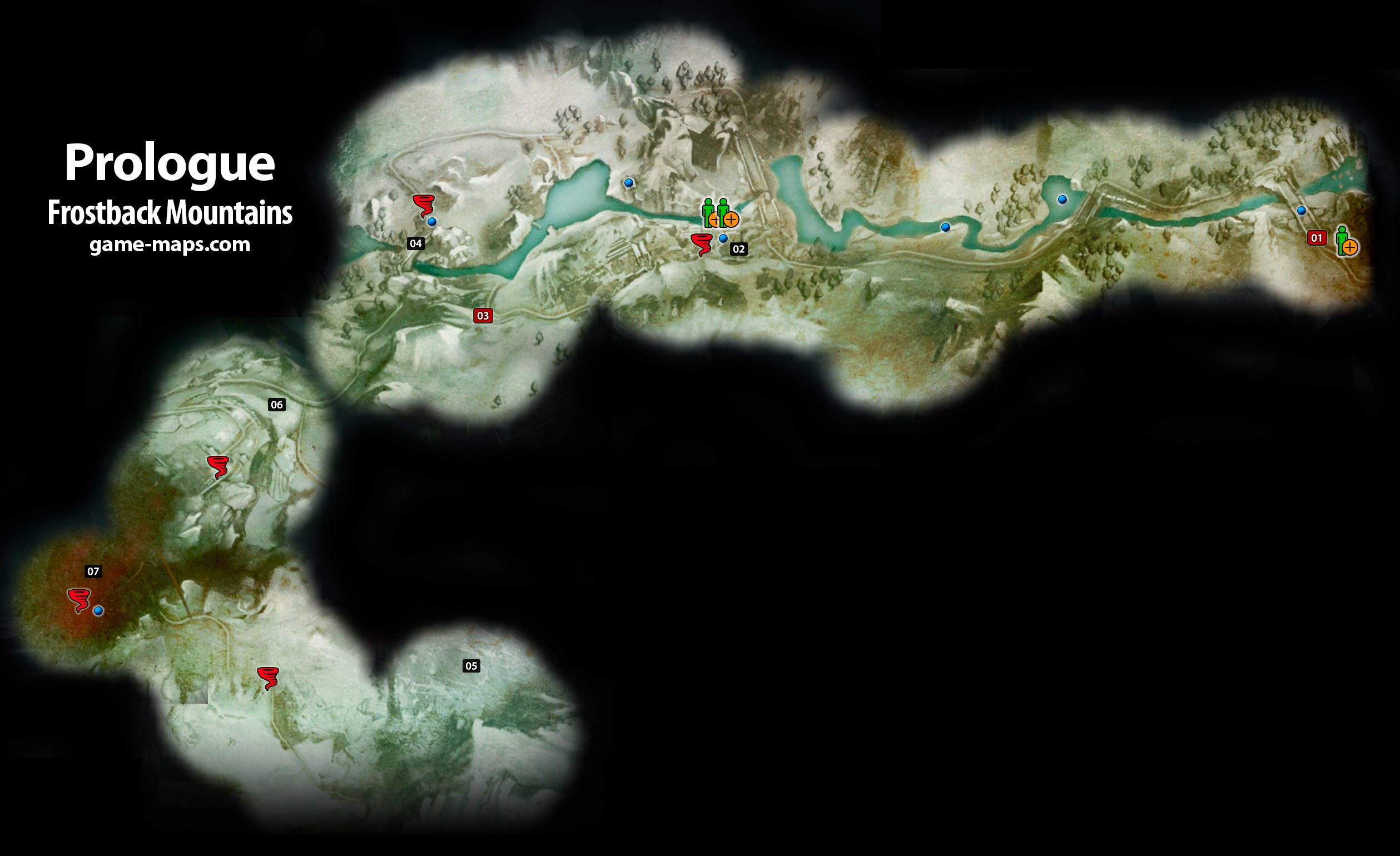
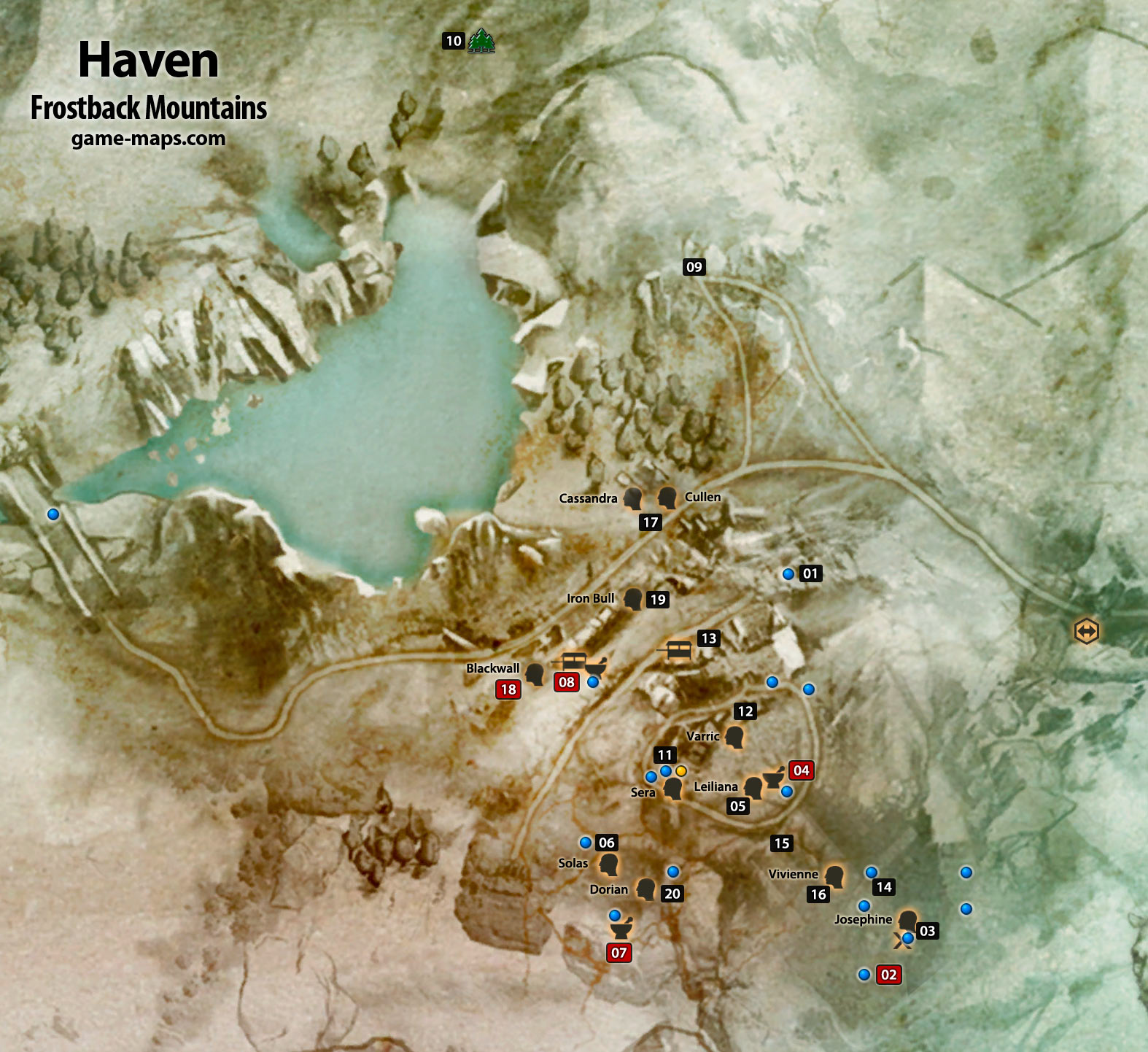
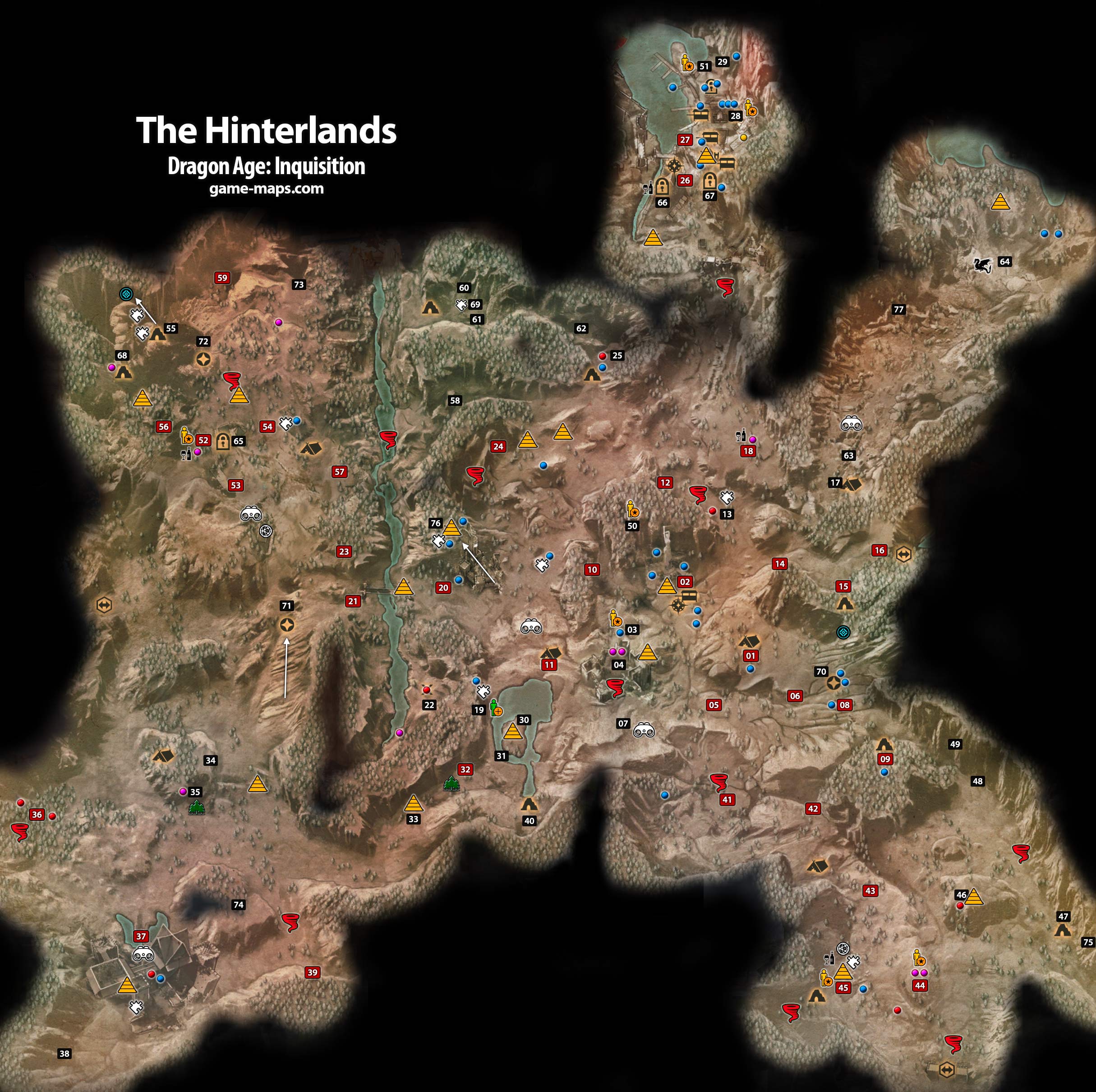
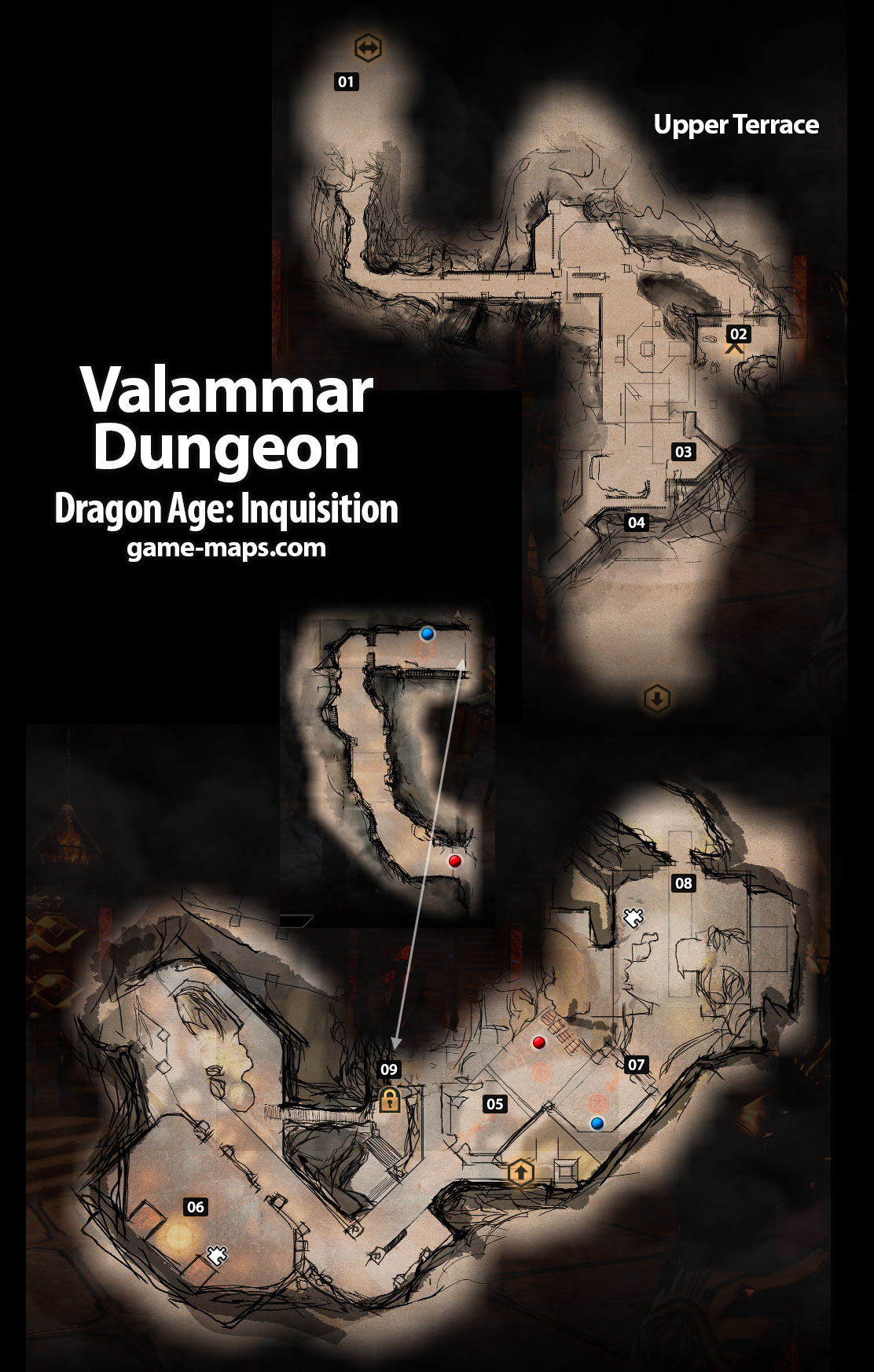
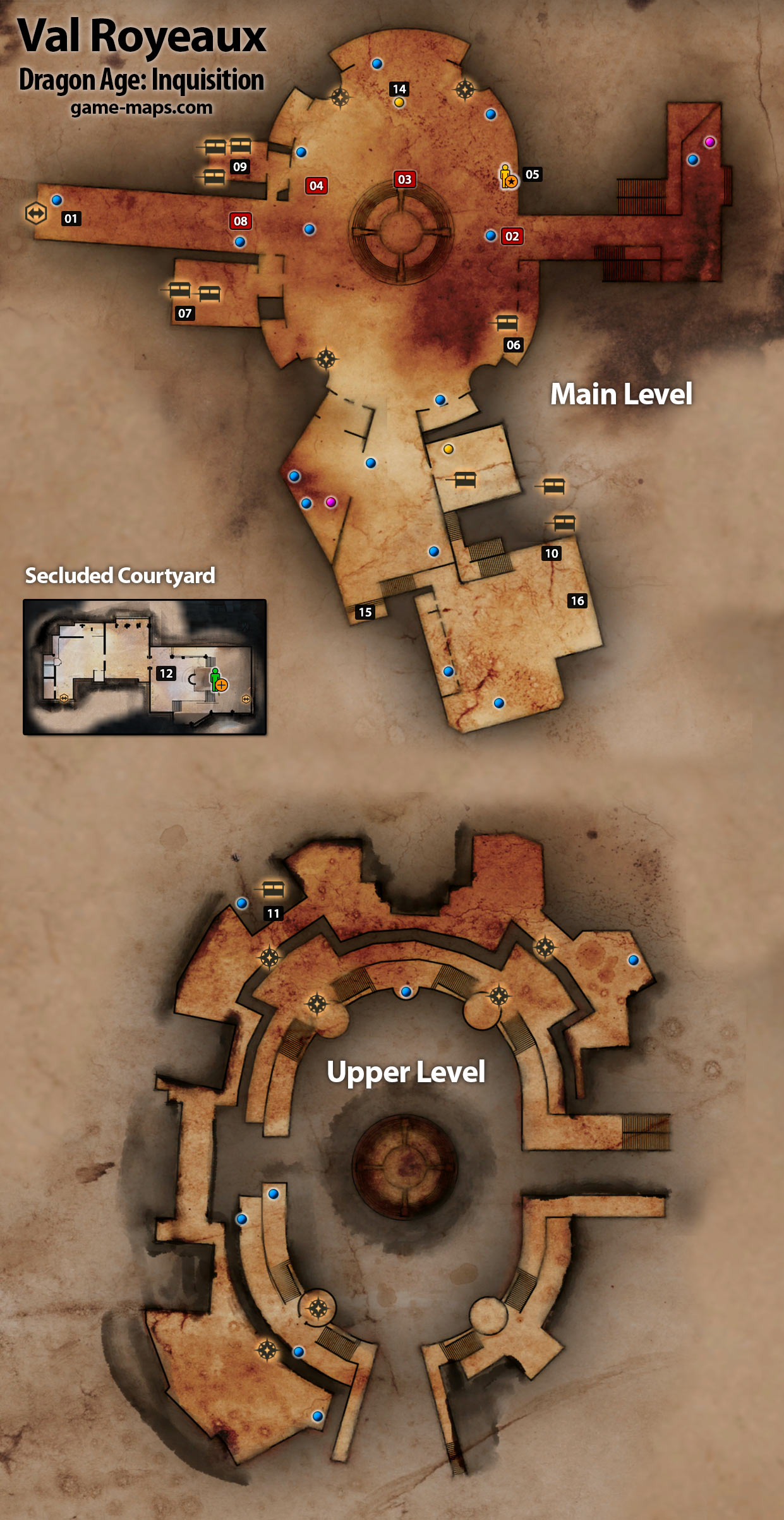
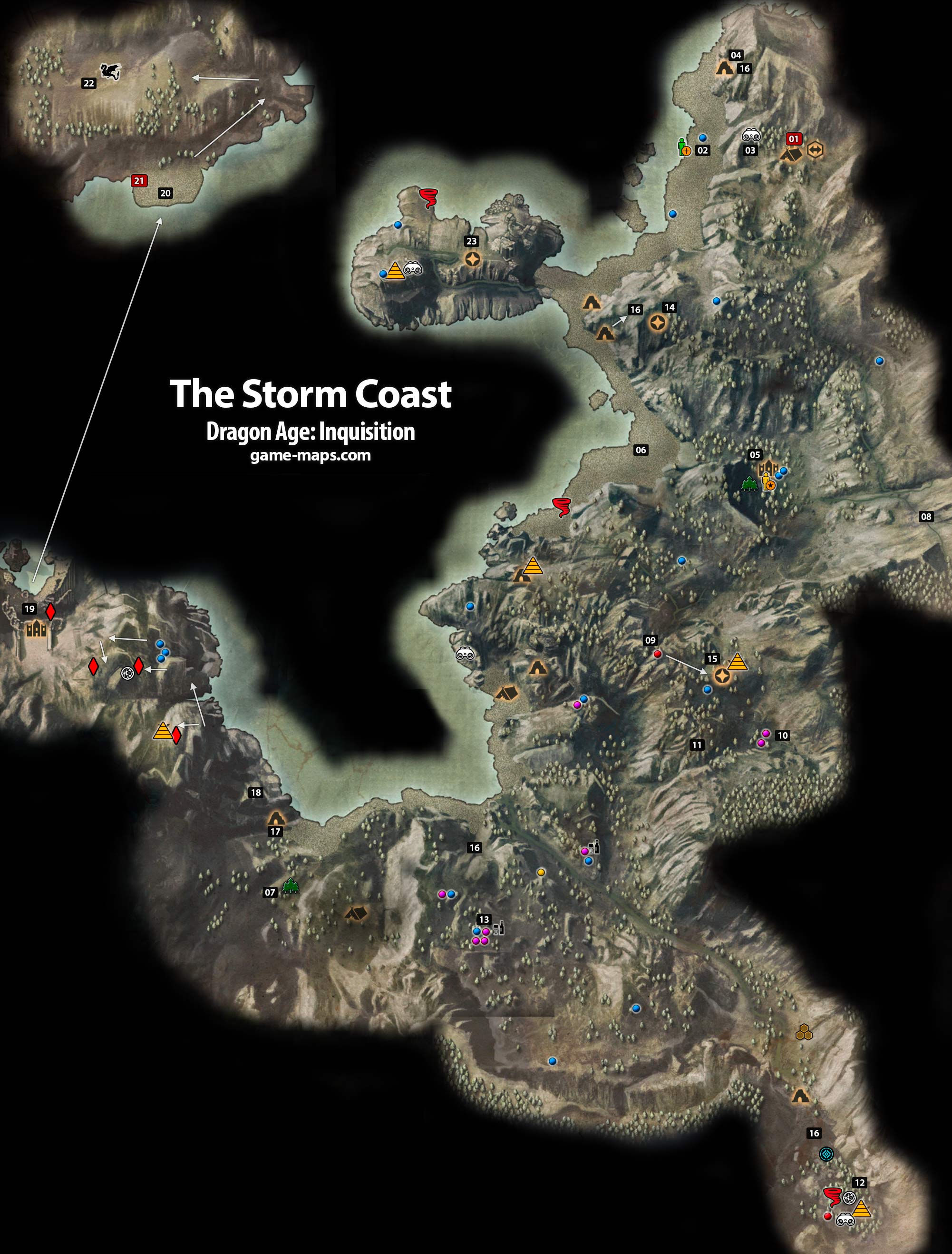

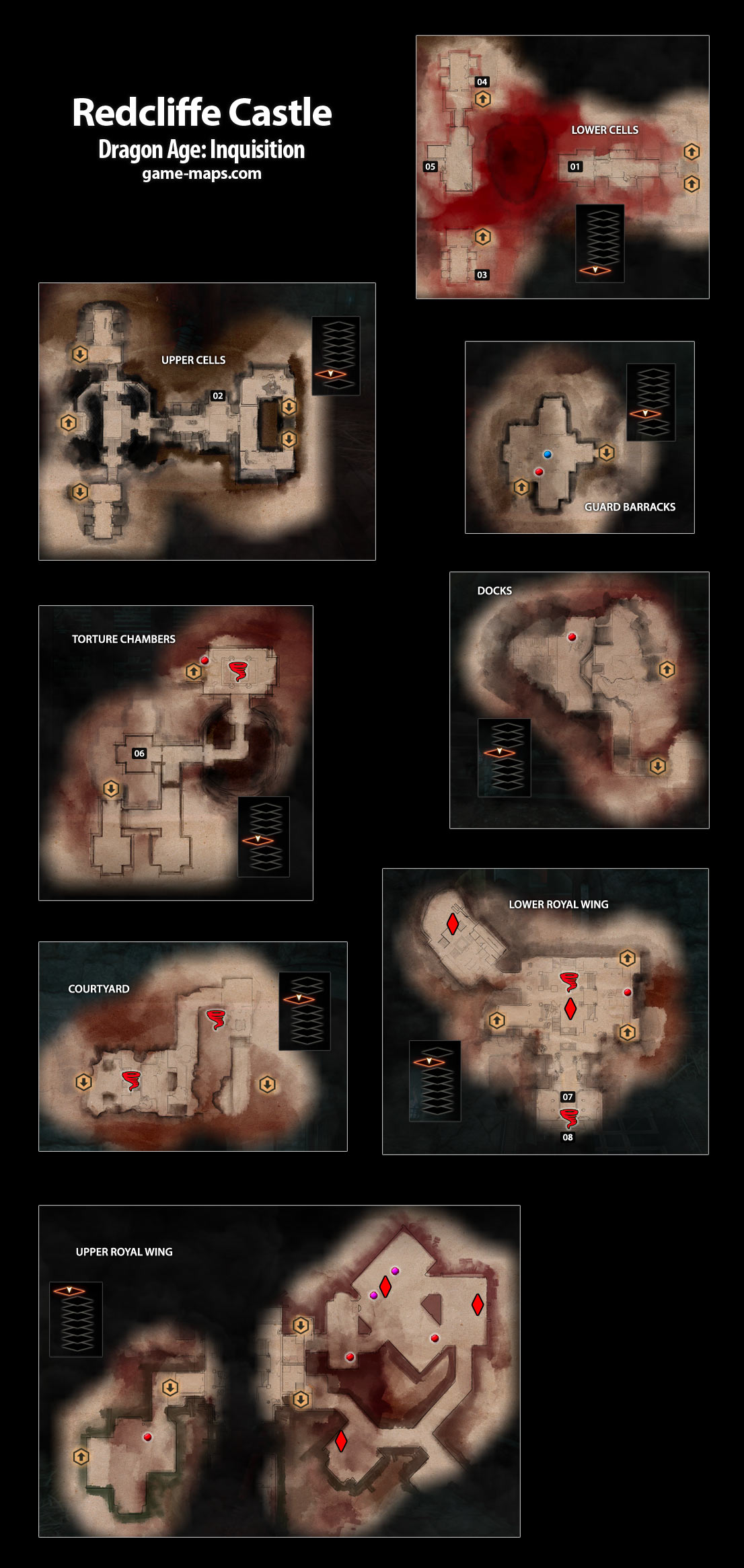
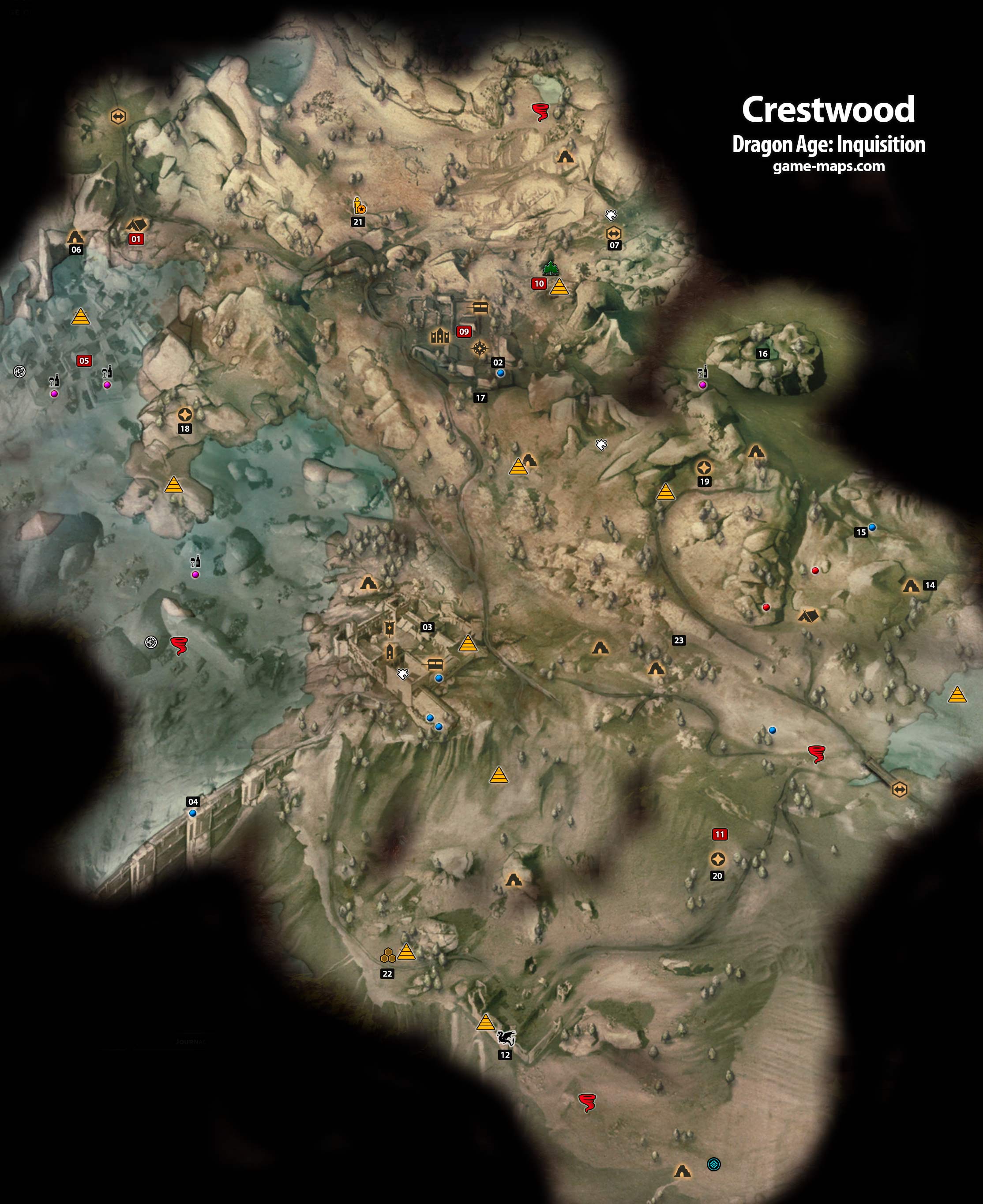
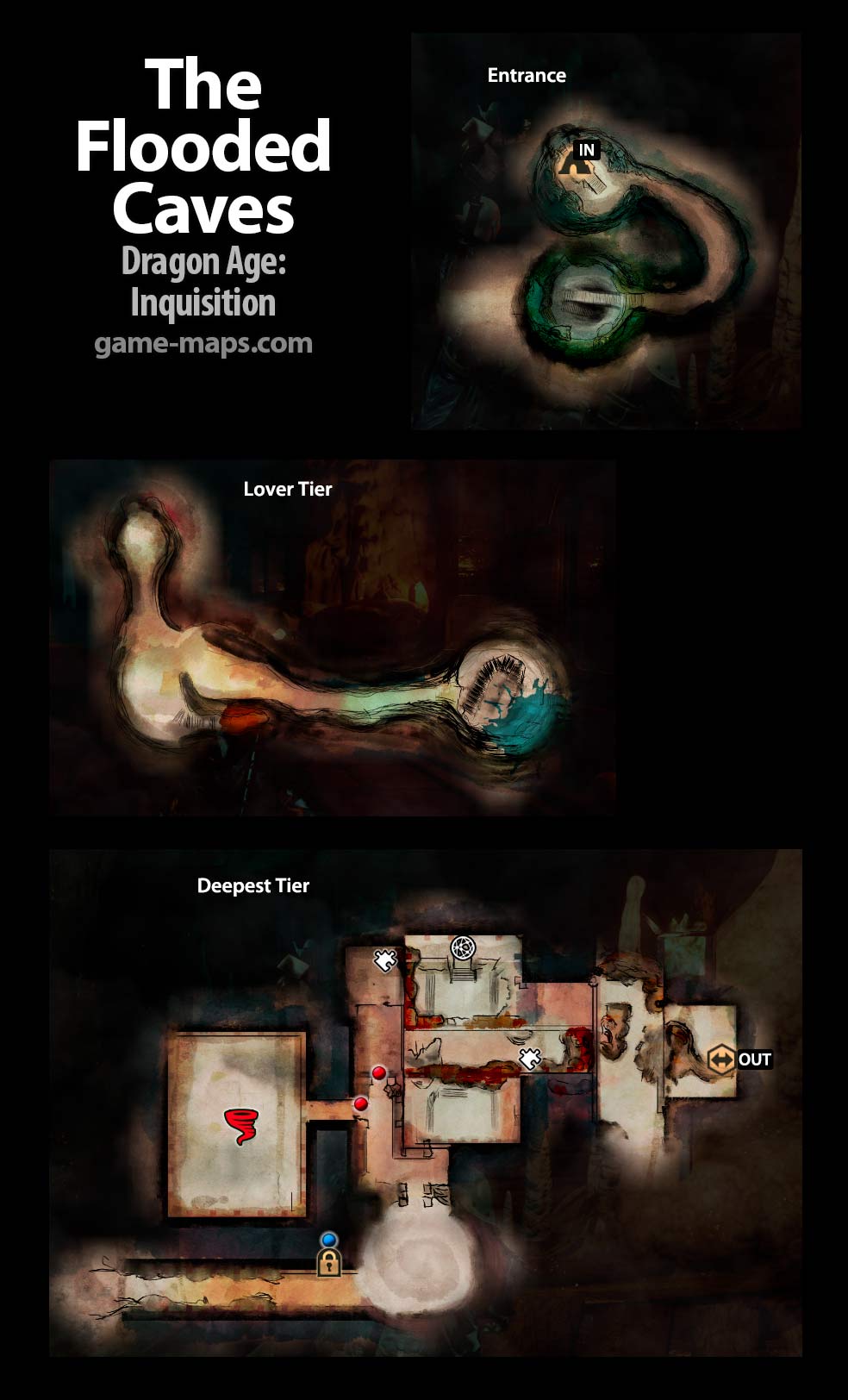
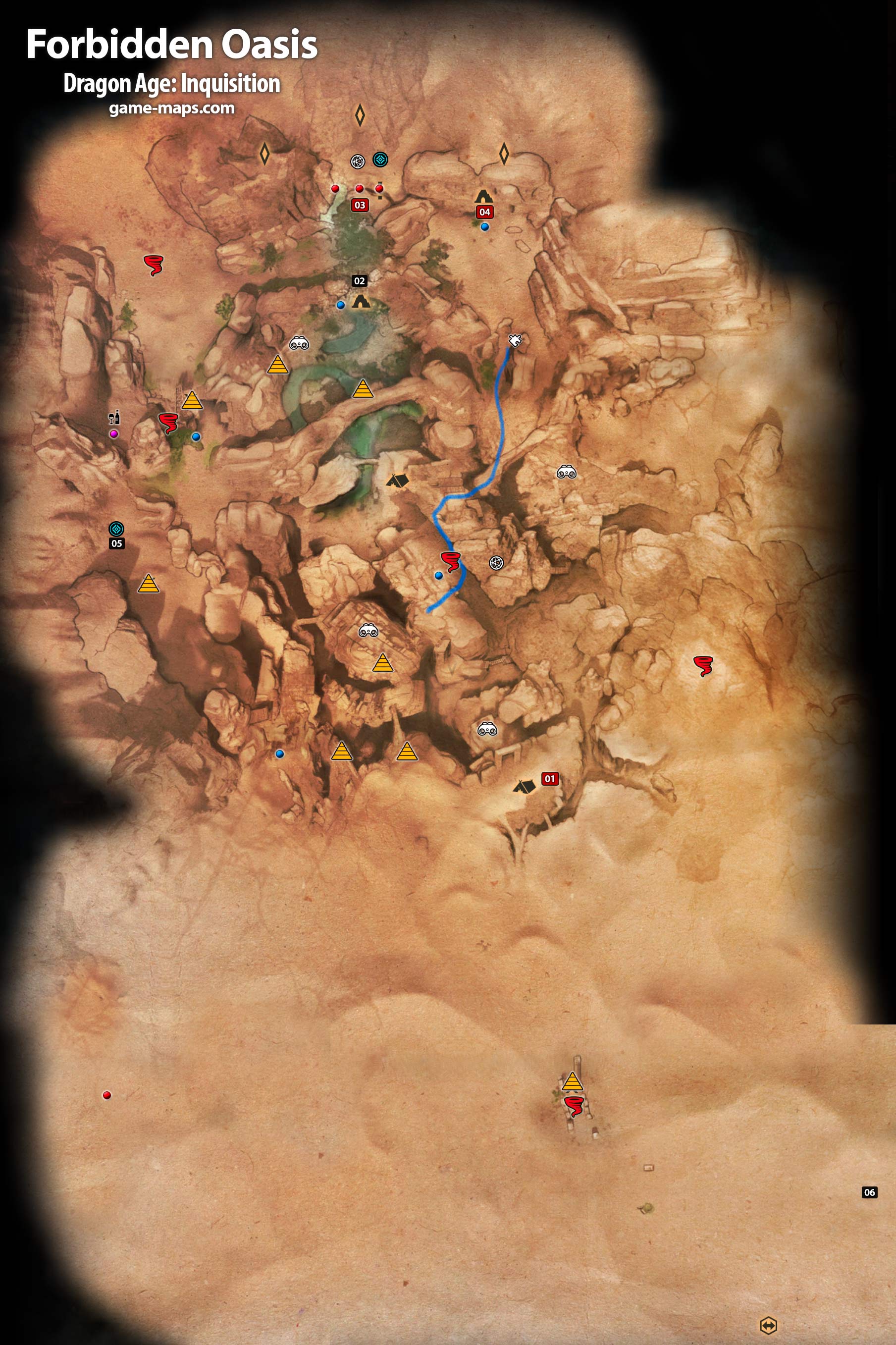
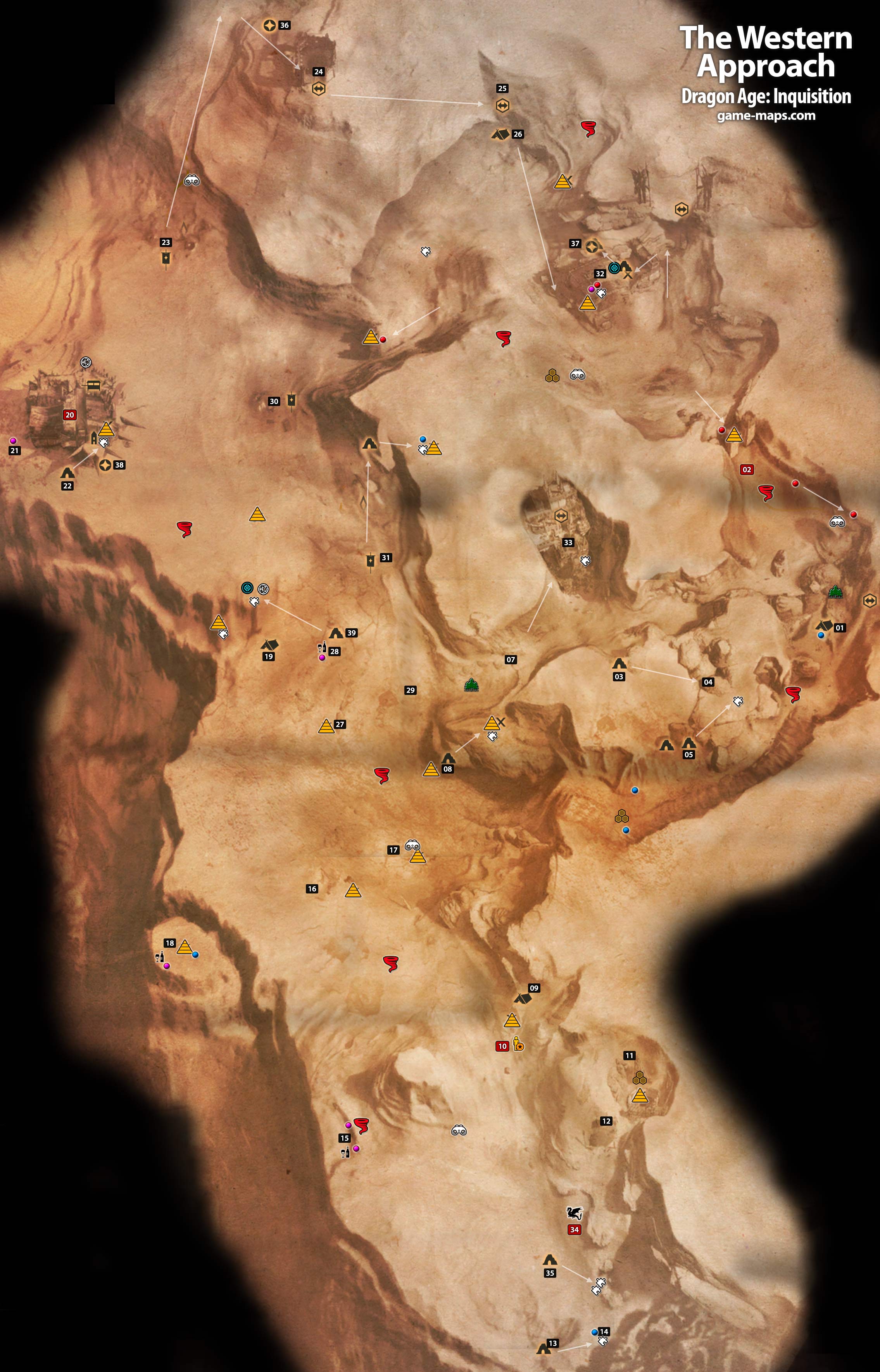
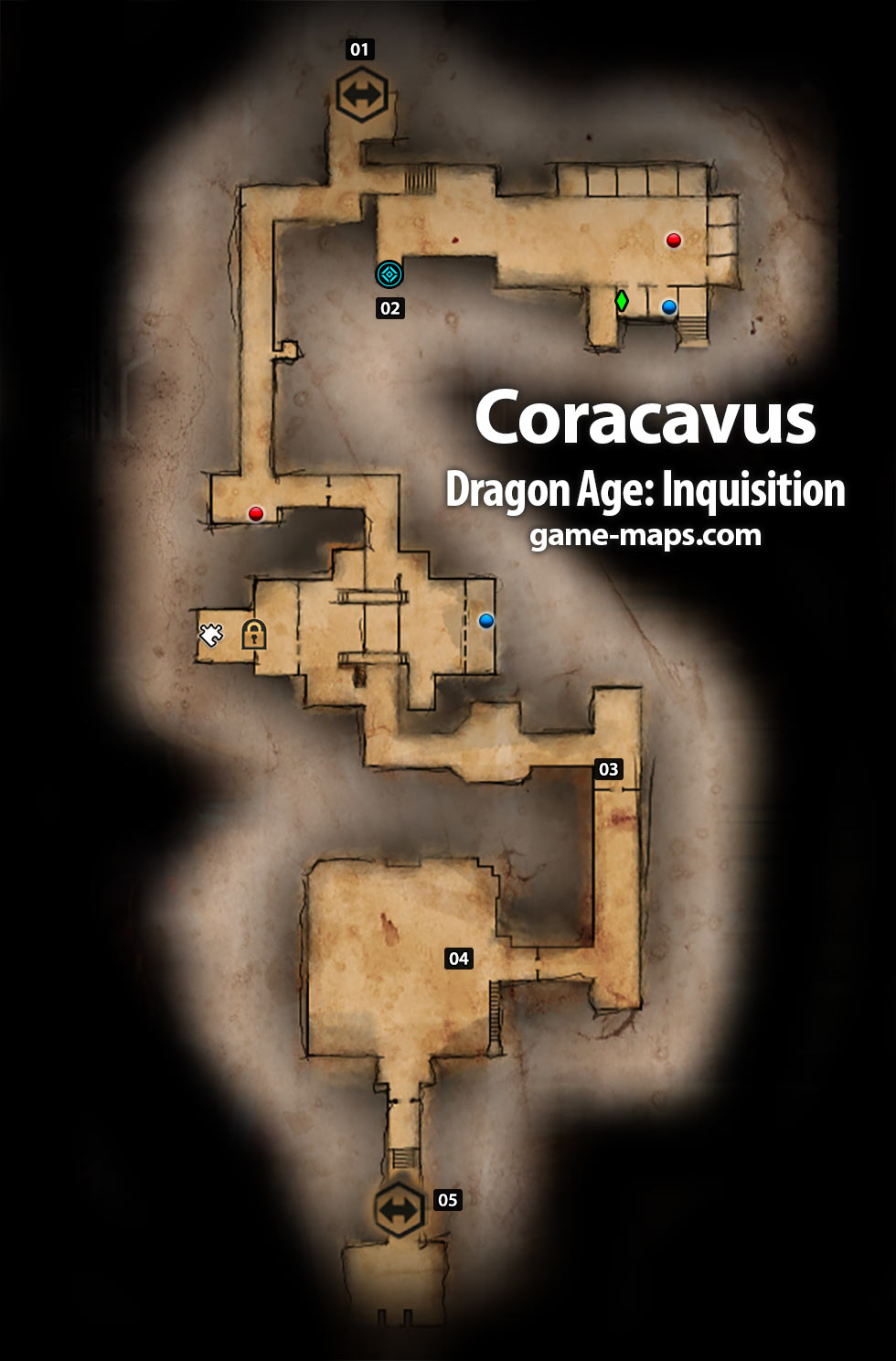
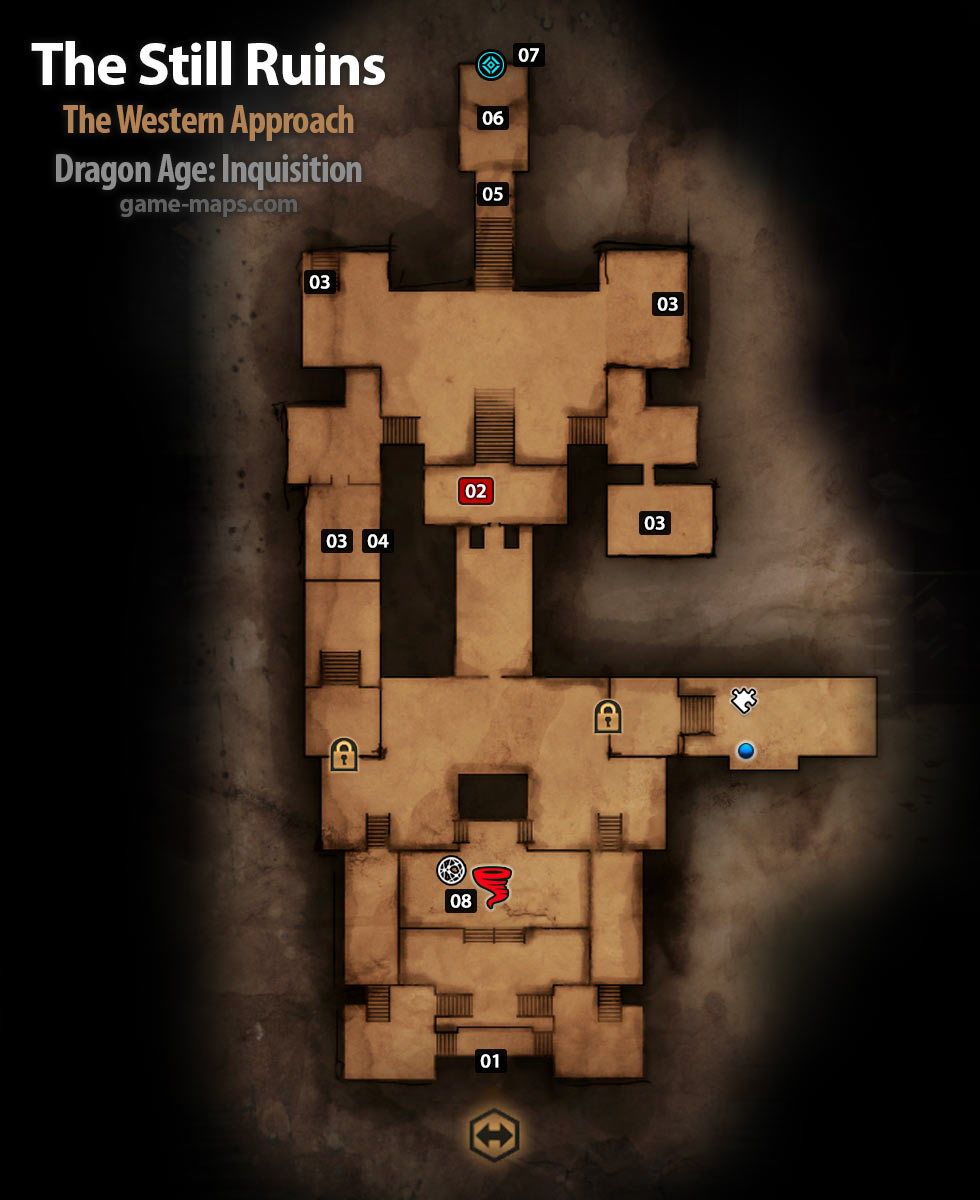
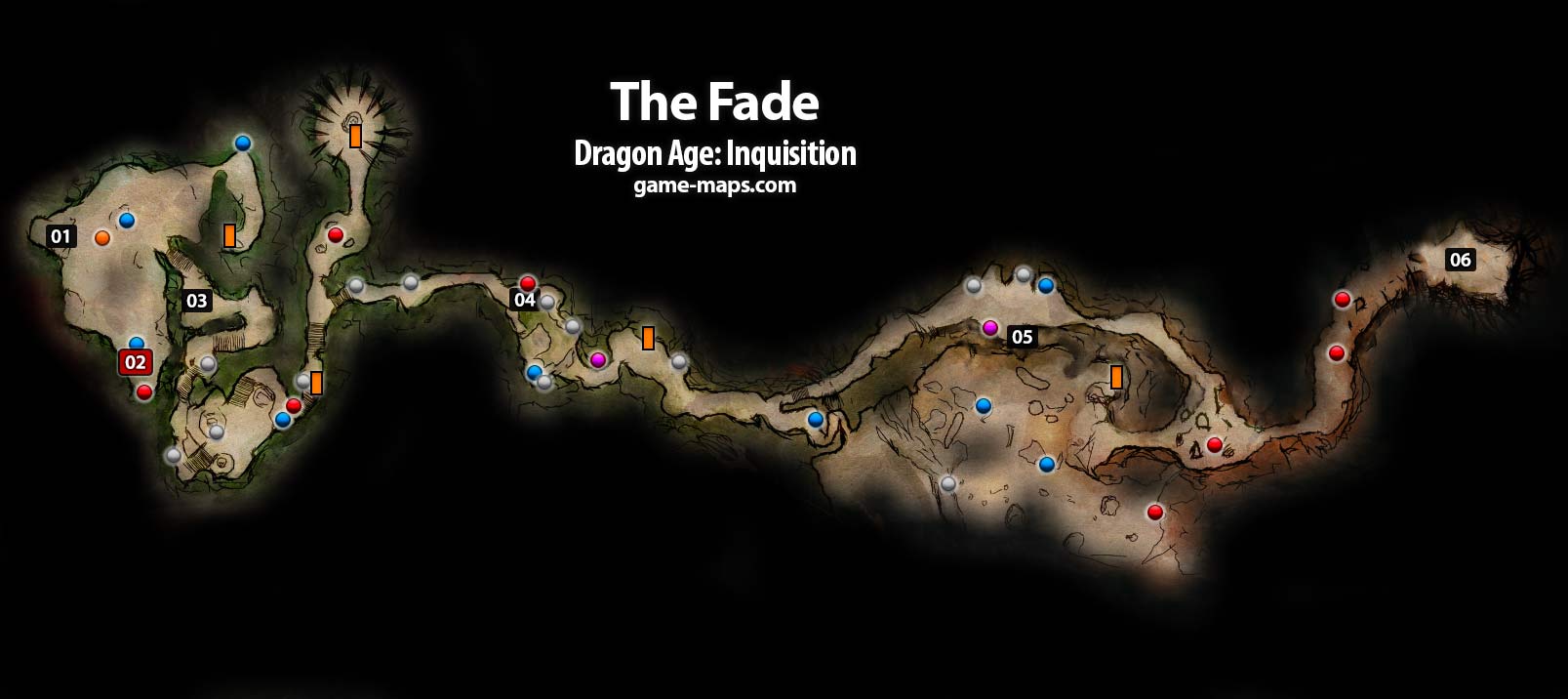
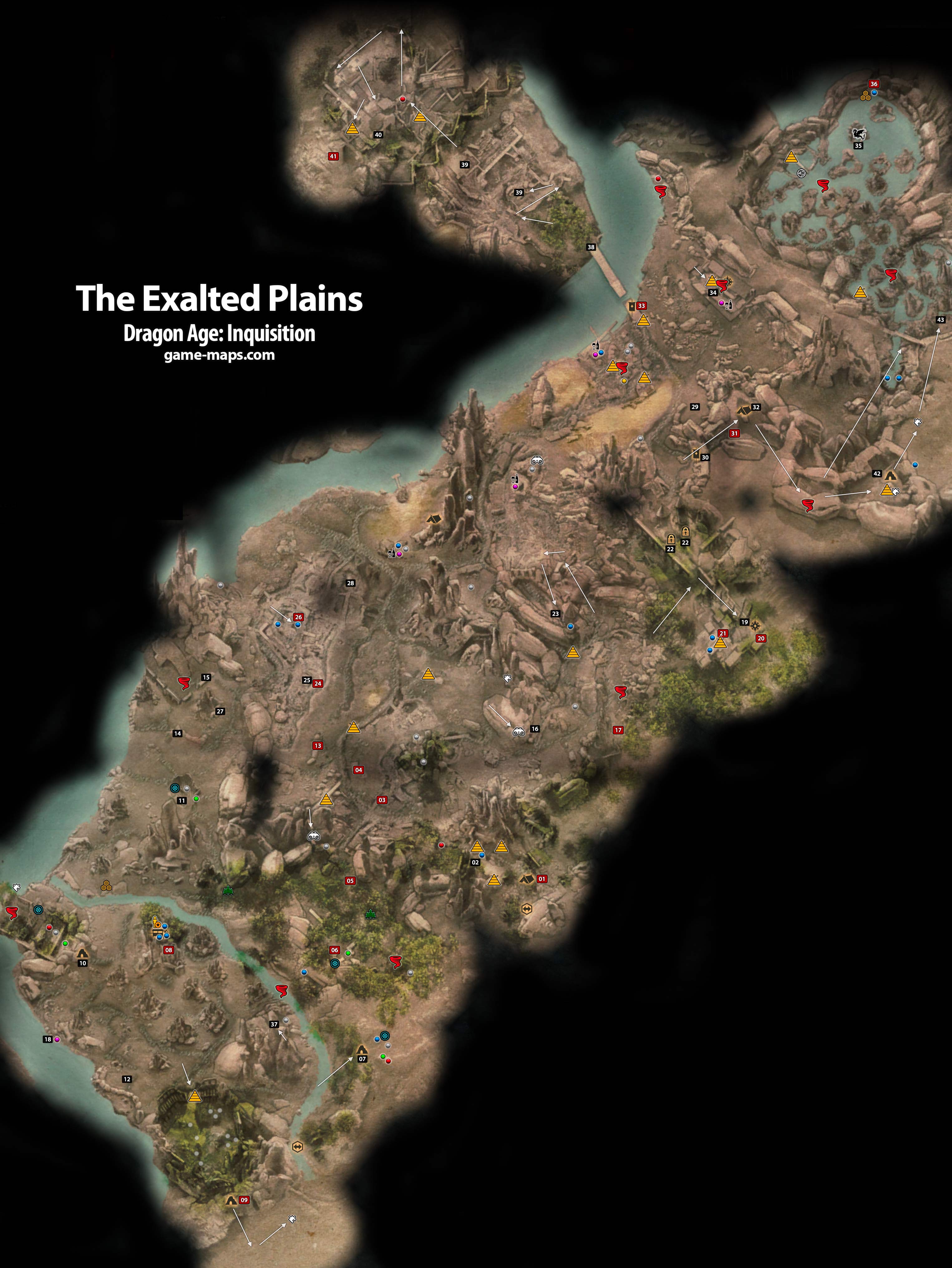
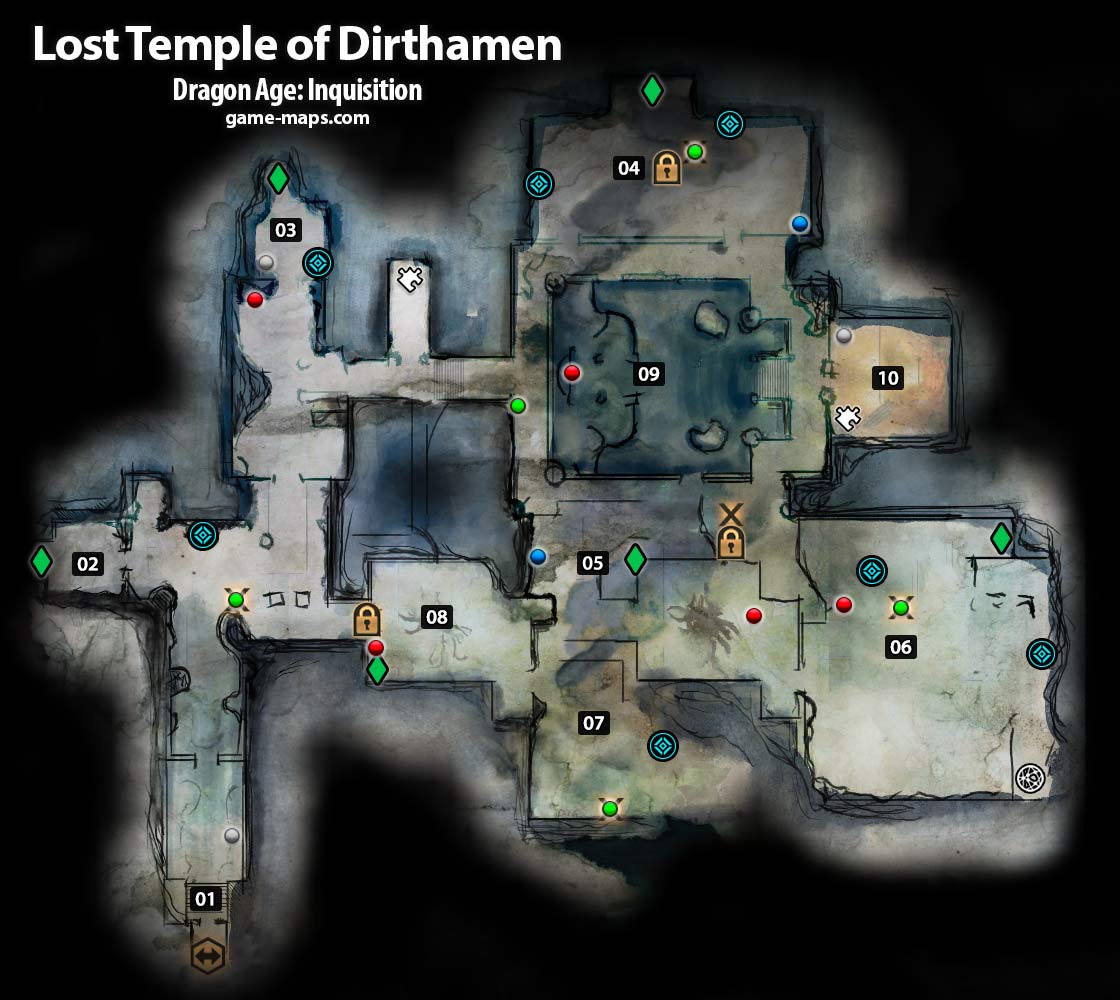
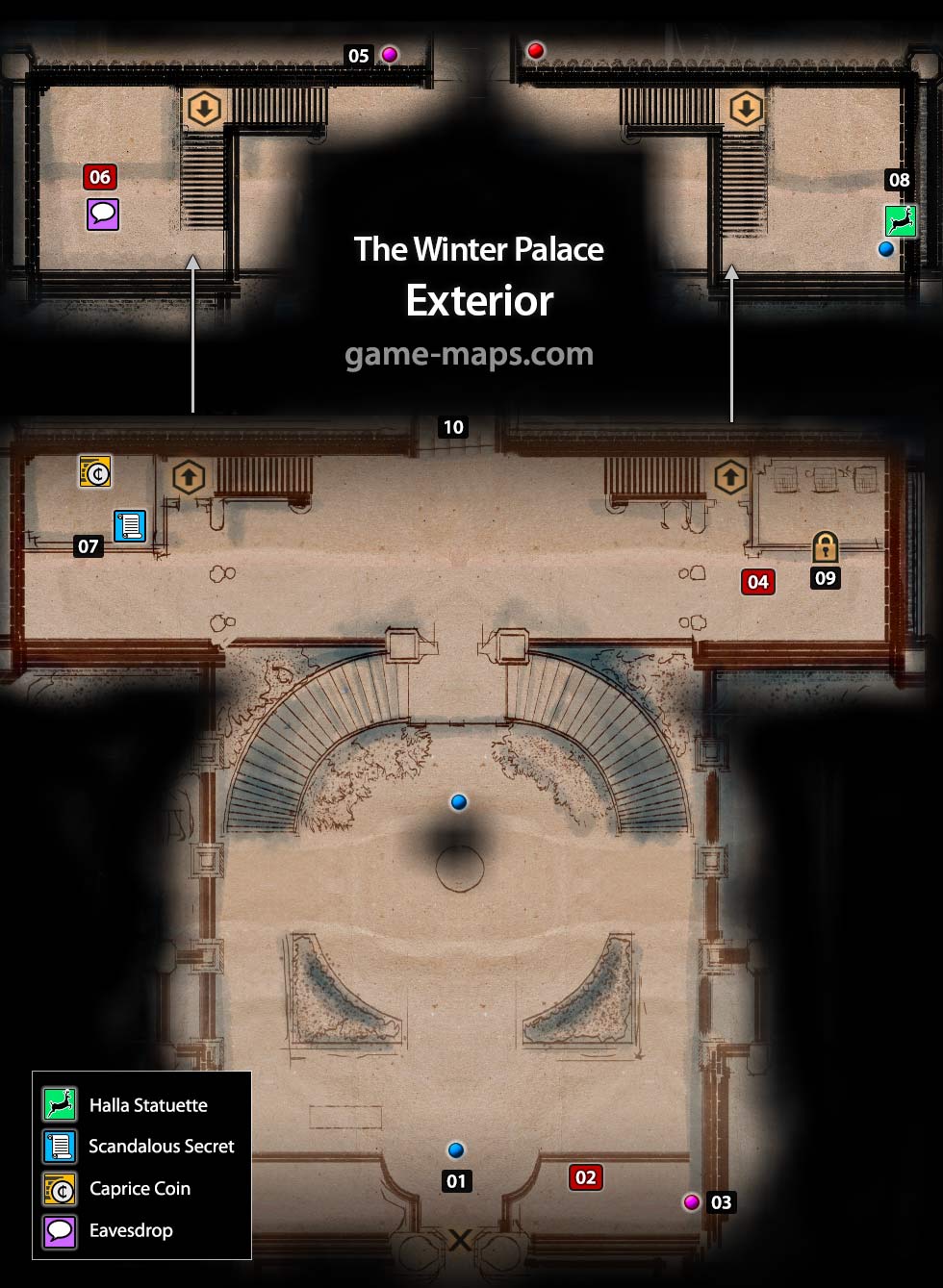
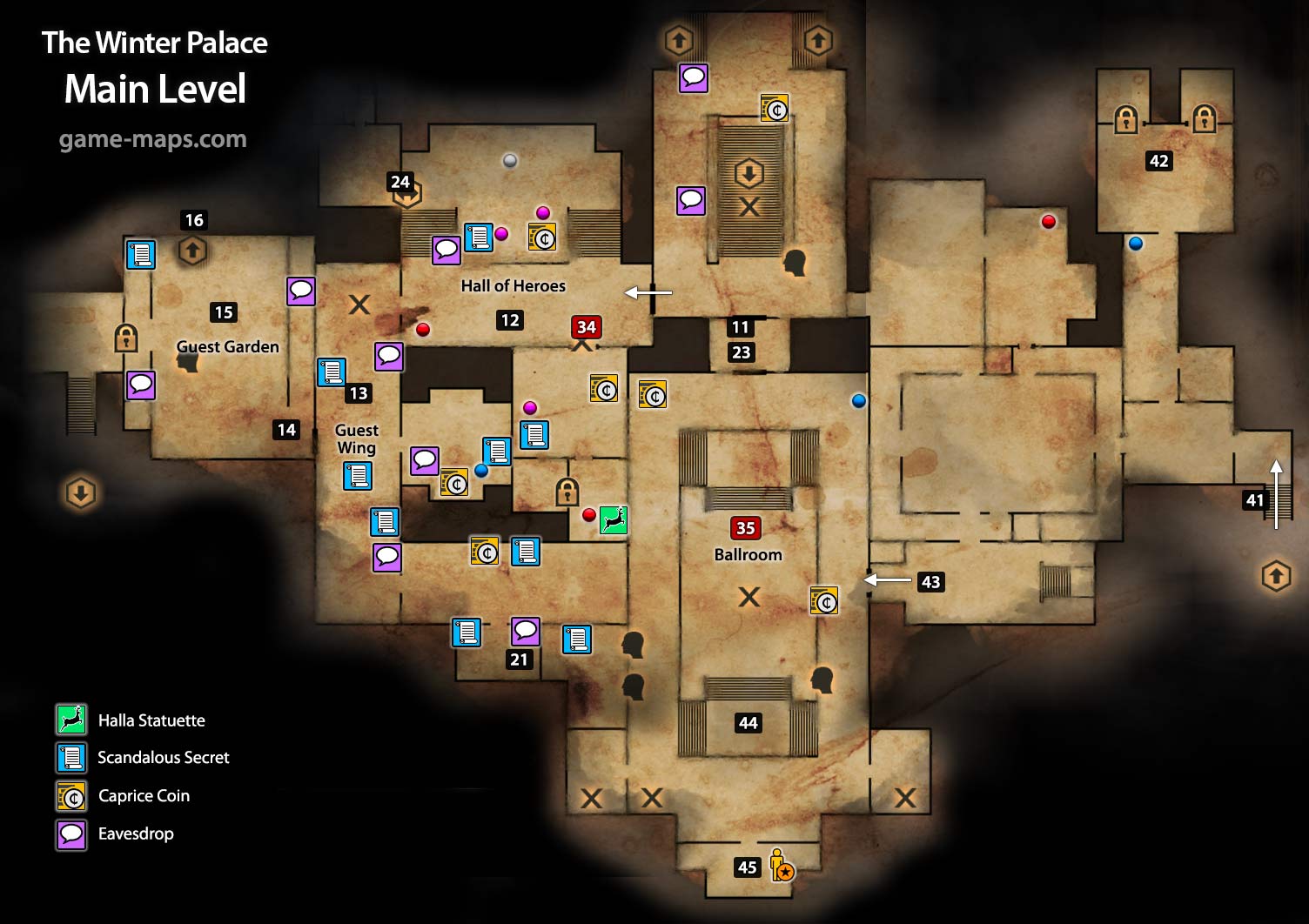
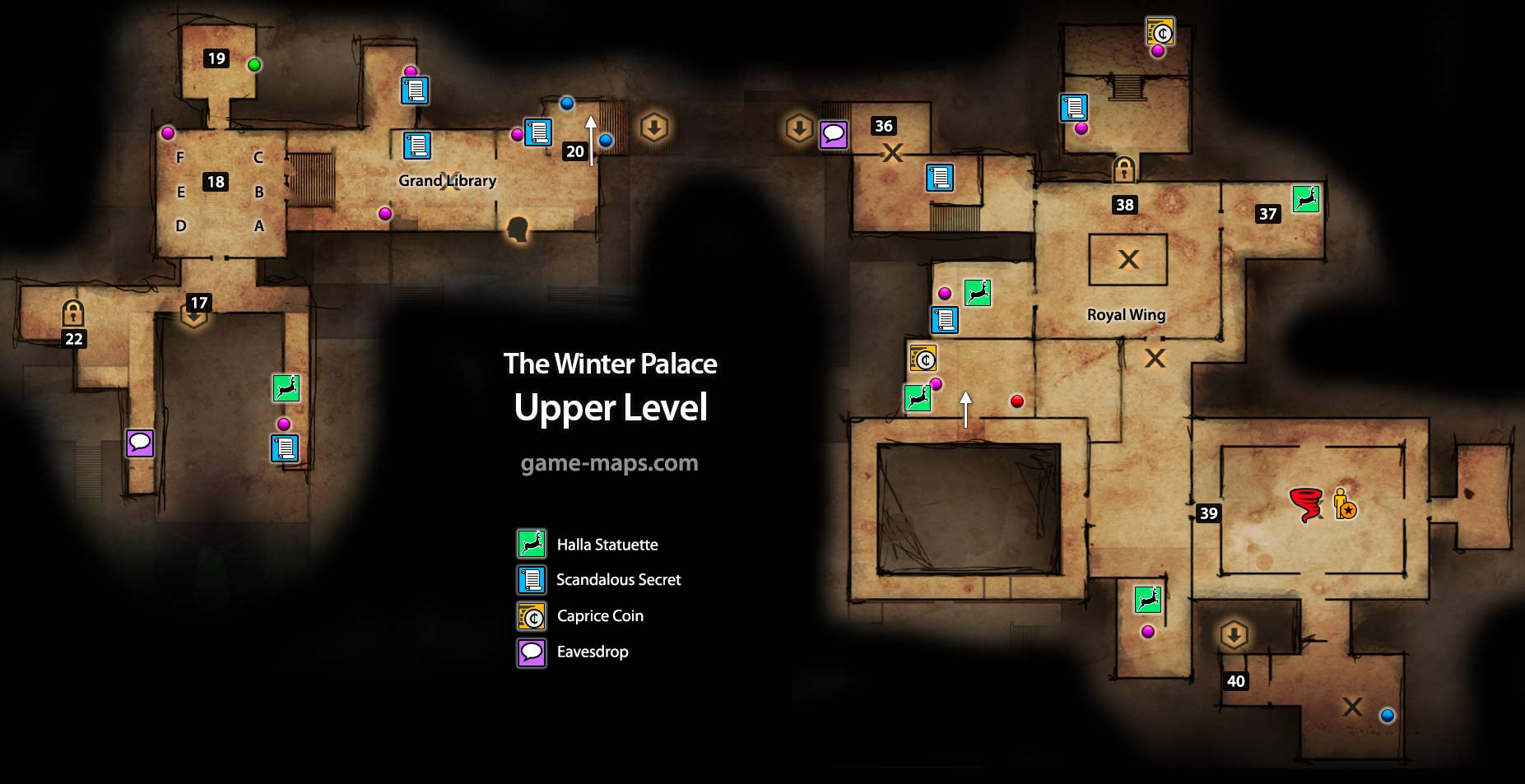
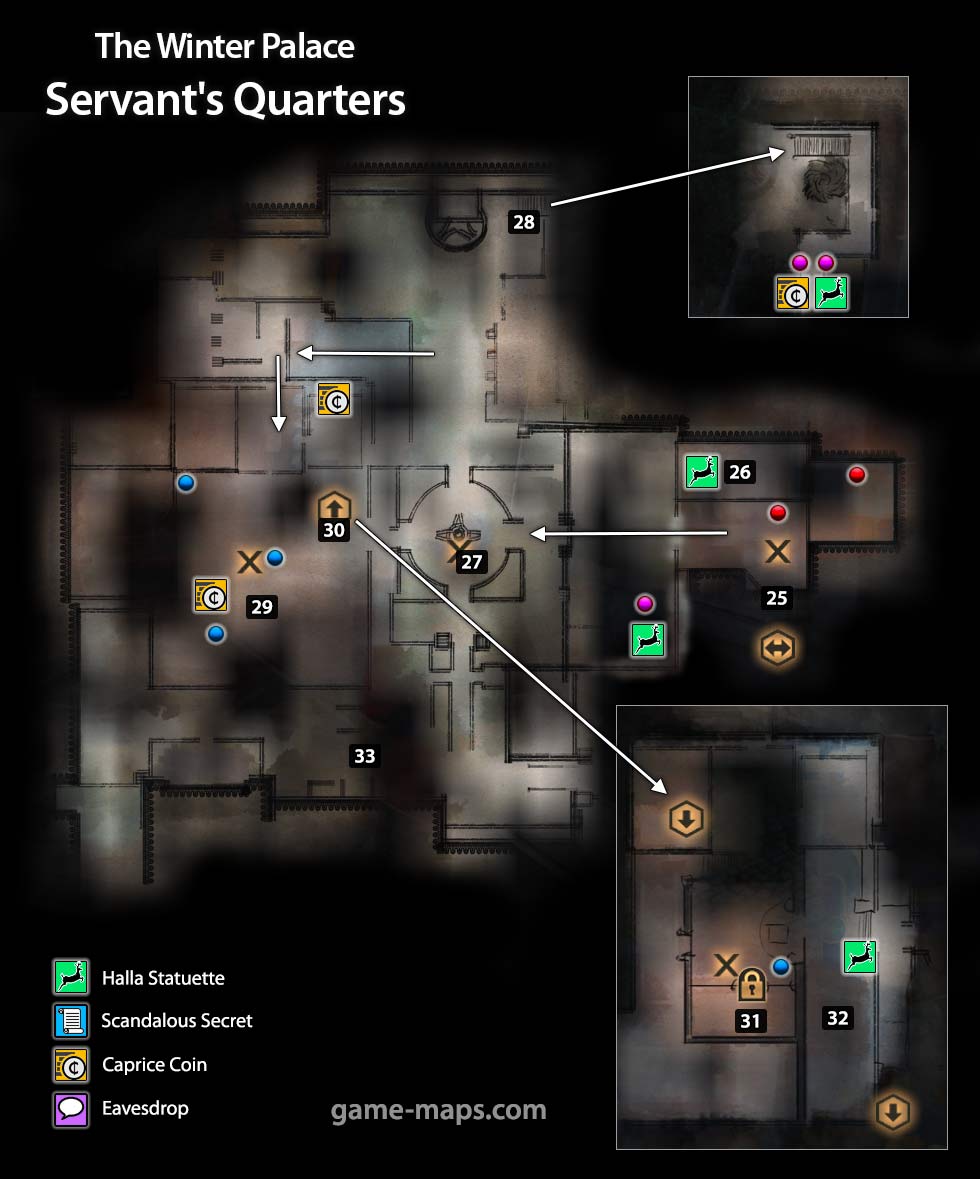

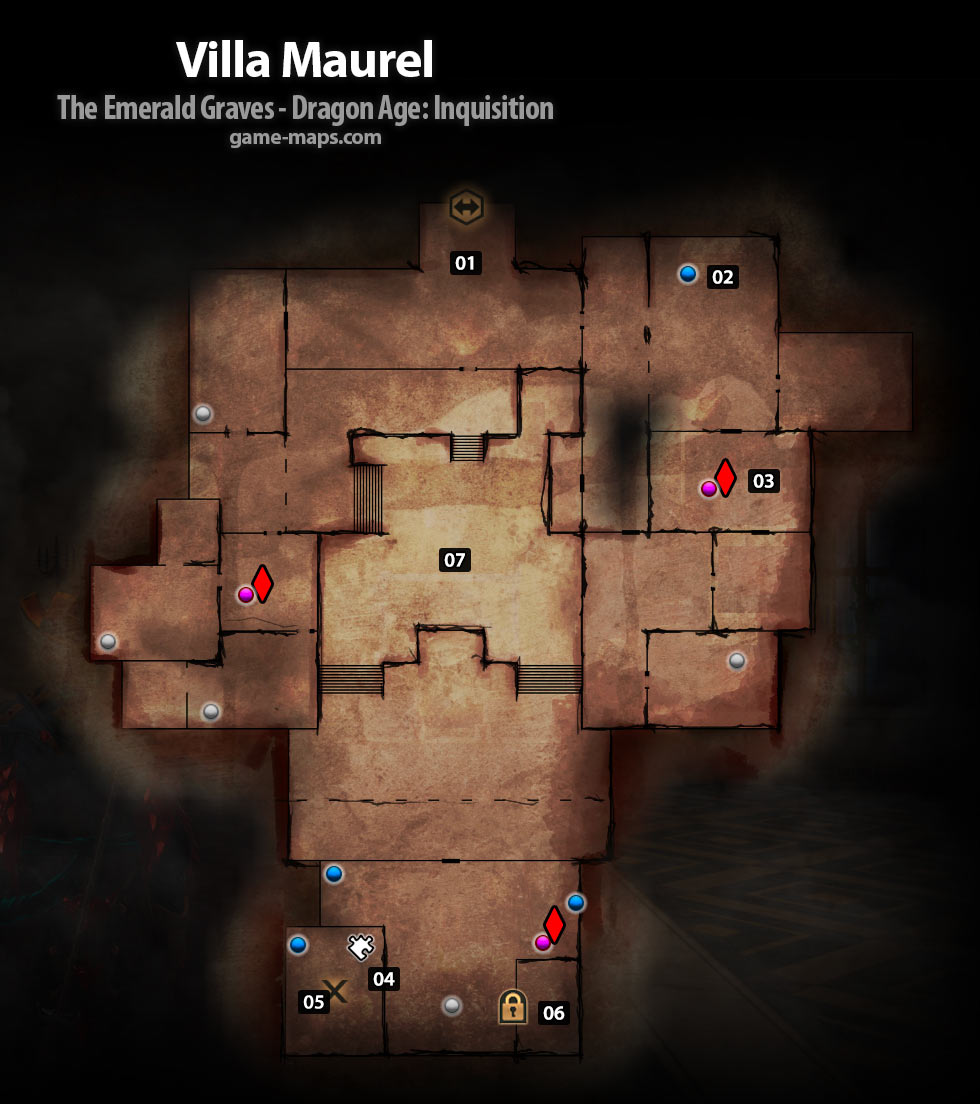

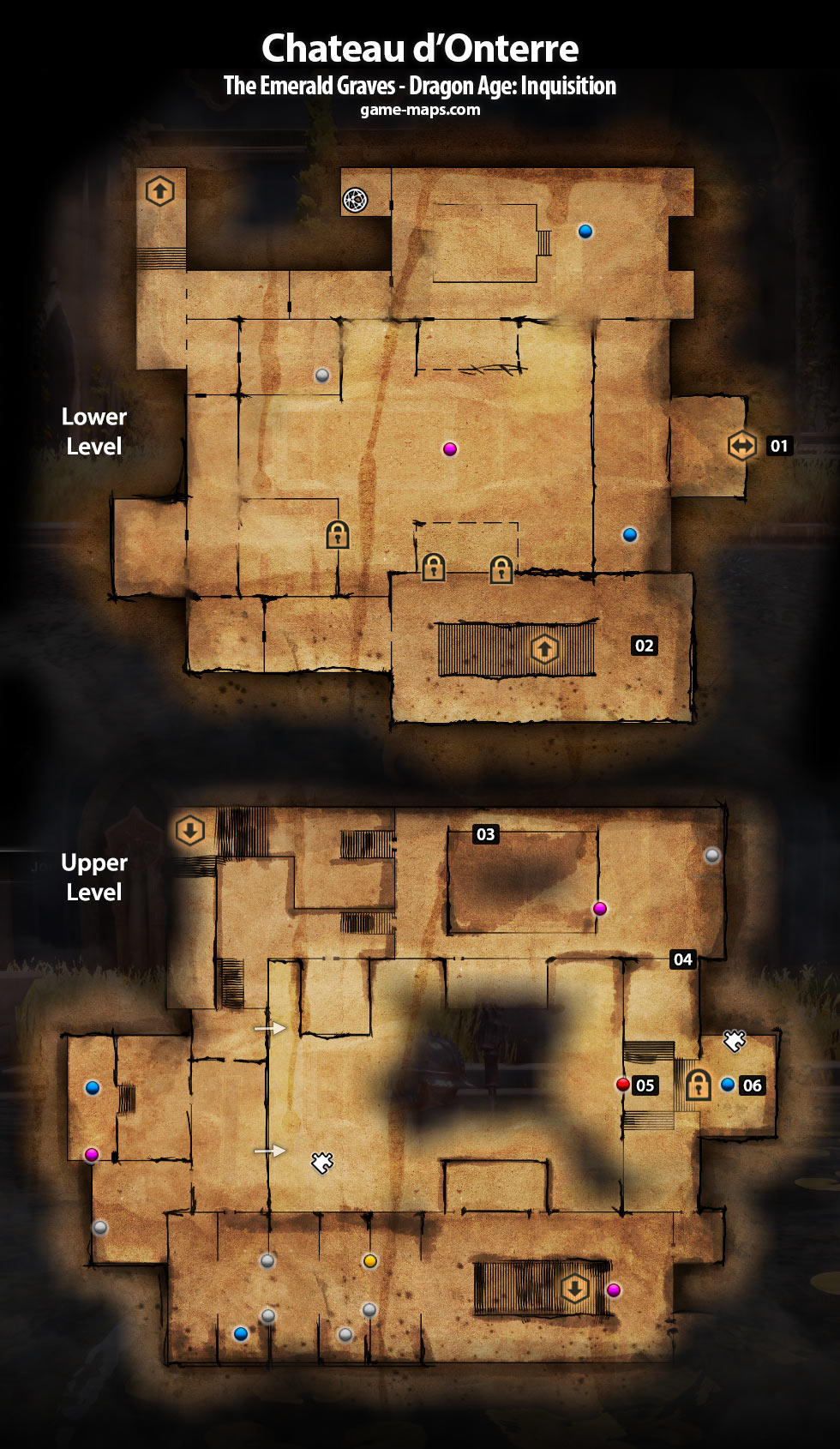
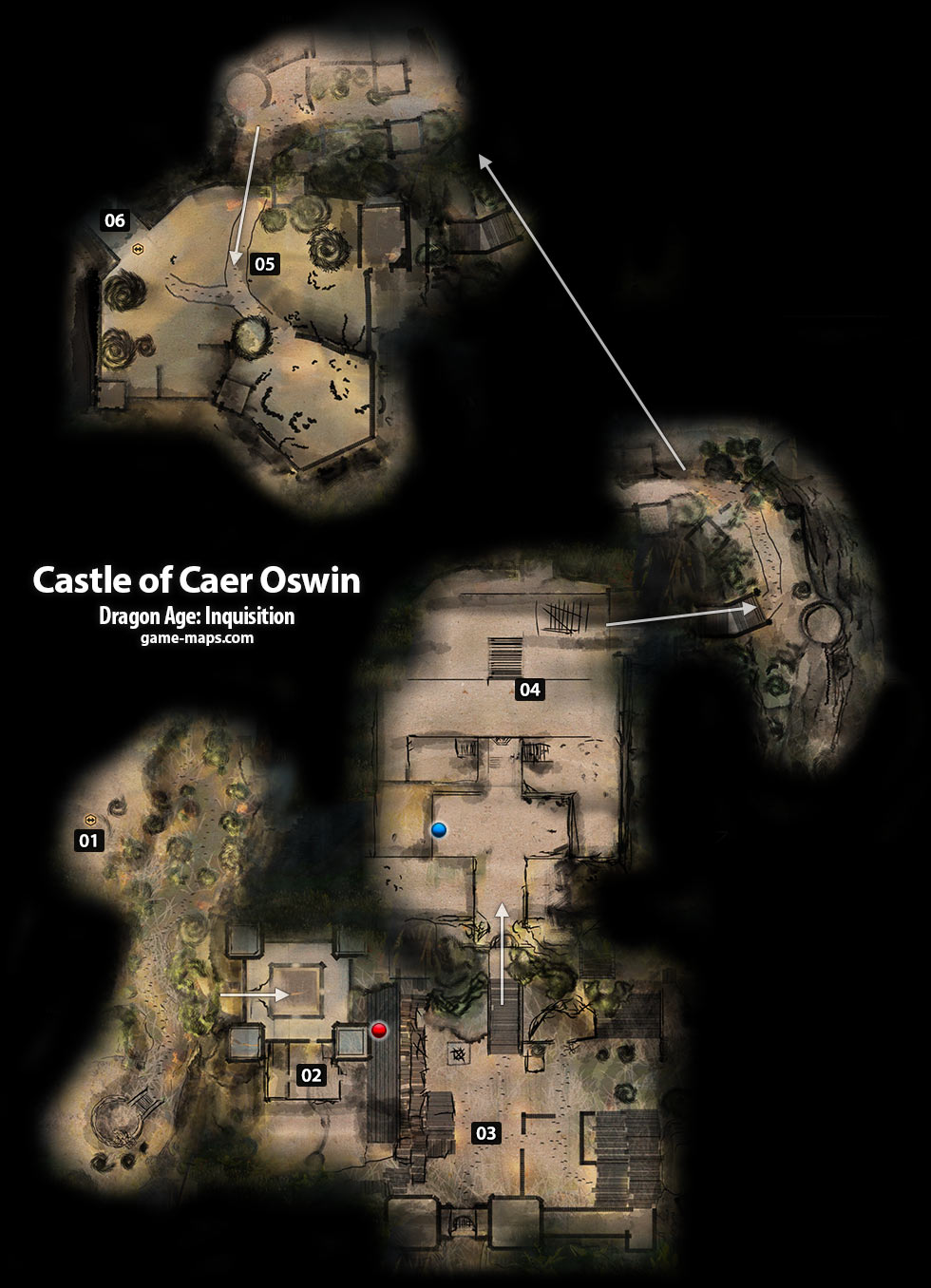

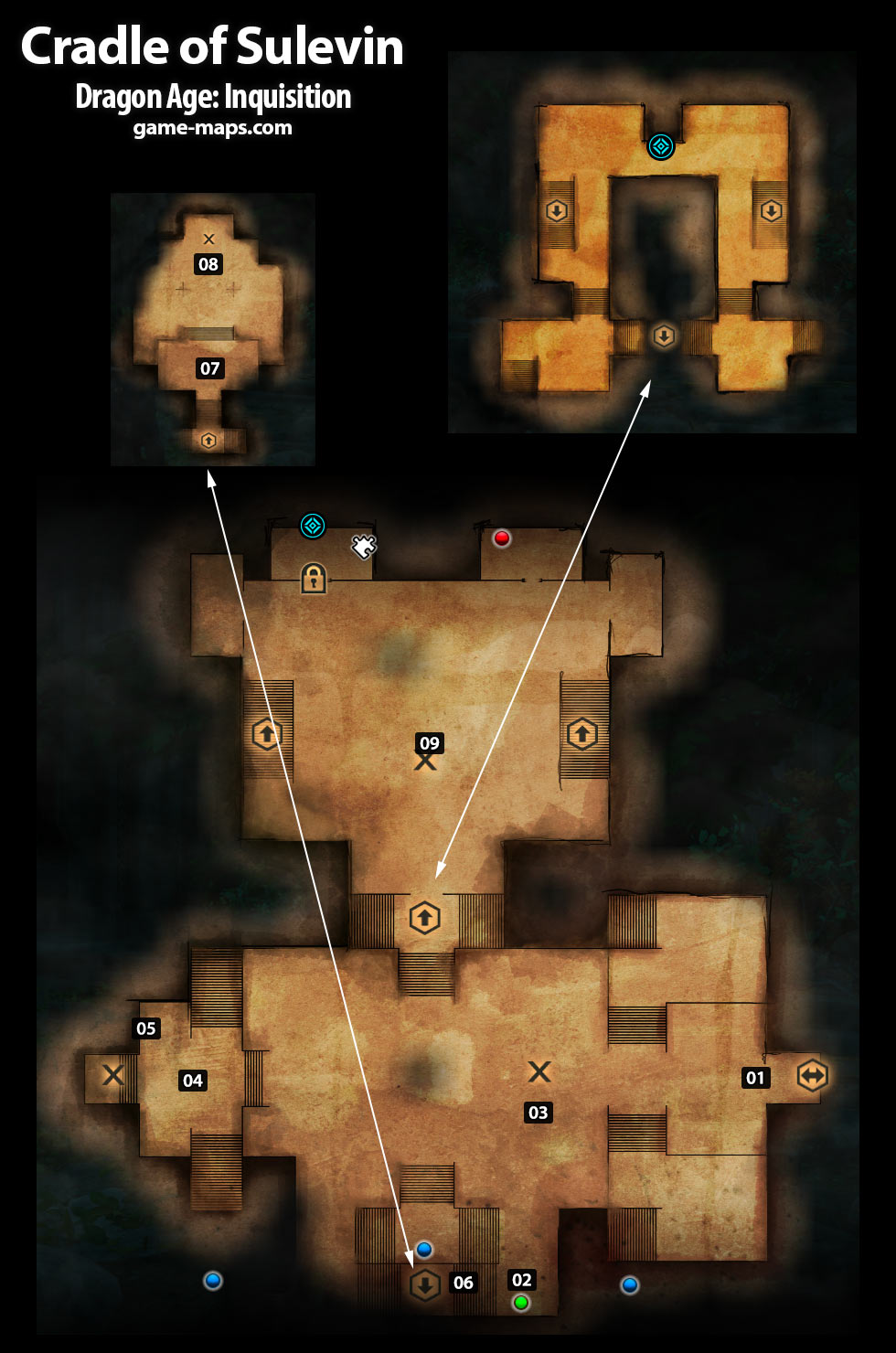
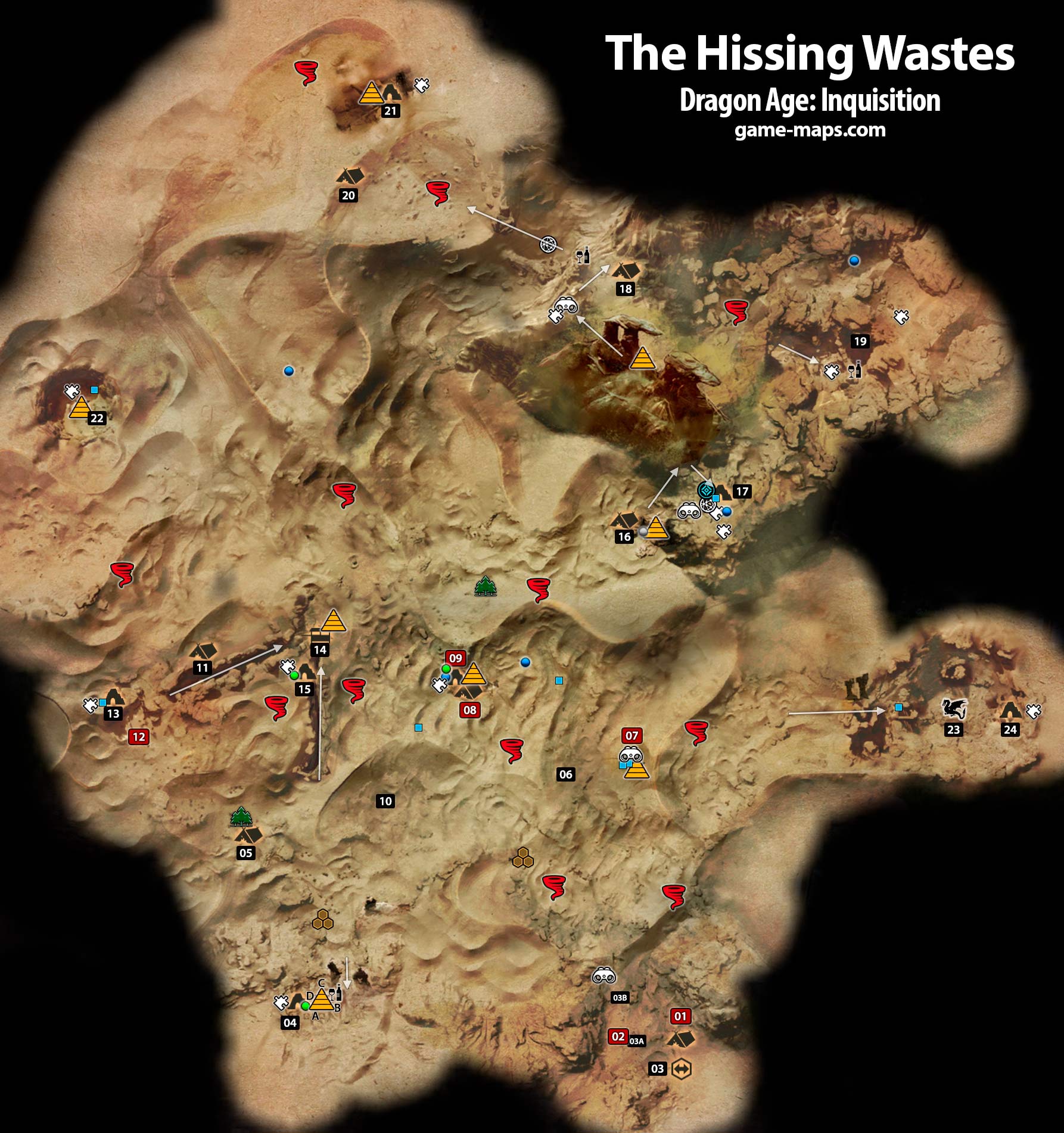
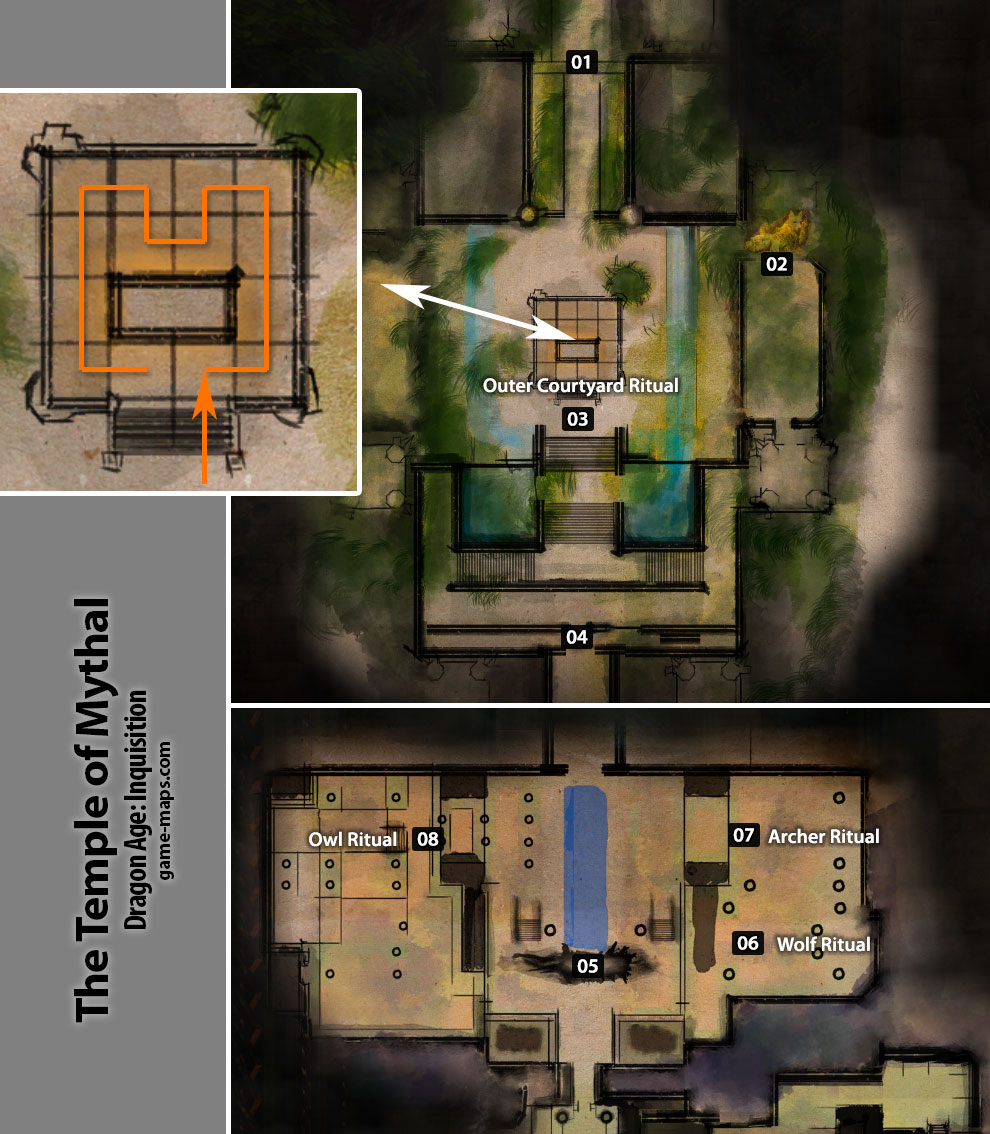


User Comments
All your comments, suggestions and corrections are very welcome. Your experience helps other players. Each comment will be read and the information contained therein used to improve the content of this page. Thank You.